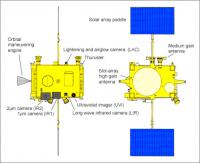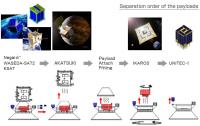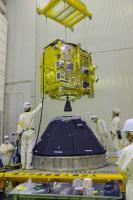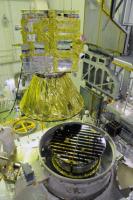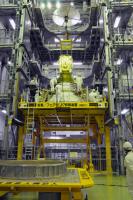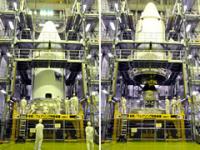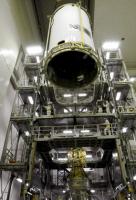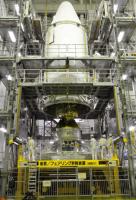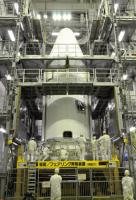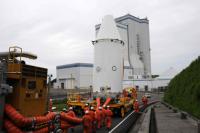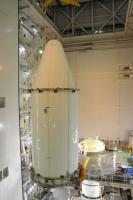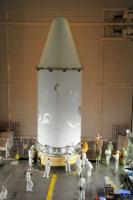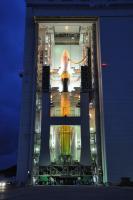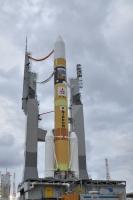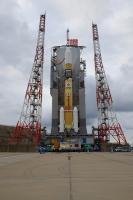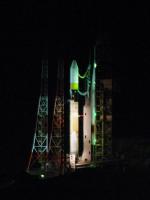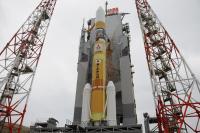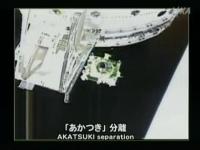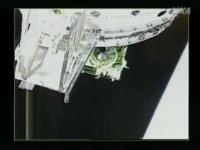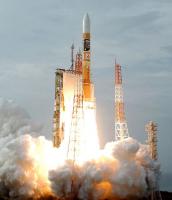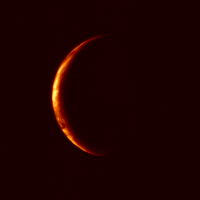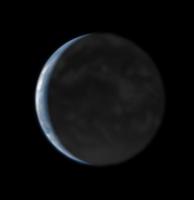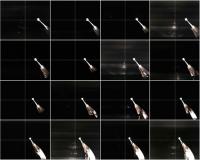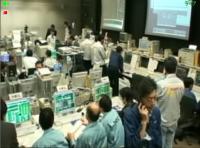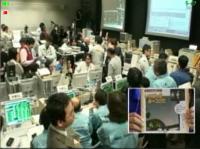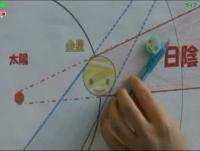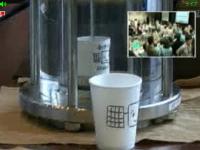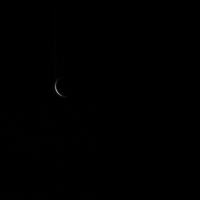Printable Version of Topic
Click here to view this topic in its original format
Unmanned Spaceflight.com _ Venus _ Akatsuki Venus Climate Orbiter
Posted by: Paolo Mar 13 2010, 11:29 AM
I thought it was time to start a separate thread on this mission, launching soon
some good medium-resolution images of the spacecraft are available on JAXA digital archives
http://jda.jaxa.jp/jda/p3_e.php?time=N&mode=level&genre=4&category=4064&mission=4066
Posted by: Greg Hullender Mar 13 2010, 04:23 PM
Here's a link to the Akatski "Special Site," which, among other things, includes a countdown.
http://www.jaxa.jp/countdown/f17/index_e.html
In the past, we've seen Japanese sites where the English content was sparse and very hard to read, but on this site, the English is excellent, although obviously not native. As a linguist and a Japanese speaker, I'm very impressed with whoever is doing it, and wish we had some way to encourage them. (Or to encourage their bosses.)
I had actually thought we should find a way to volunteer to help polish the English for JAXA -- it would be a great way to give something back -- but it's clear they don't need that for this project. Way to go!
--Greg
Posted by: punkboi Mar 18 2010, 06:00 PM
March 18, 2010 Updated
AKATSUKI leaves for Tanegashima
The Venus Climate Orbiter "AKATSUKI" left the Sagamihara Campus for the Tanegashima Space Center (TNSC) on the evening of March 17.
The AKATSUKI will be delivered to the TNSC on the 19th. It will undergo final launch preparations there.
http://www.jaxa.jp/countdown/f17/index_e.html
Posted by: robspace54 Mar 22 2010, 02:08 PM
http://www.jaxa.jp/countdown/f17/overview/akatsuki_e.html
Planet-C (Ataksuki or the Venus Climate Orbiter) getting ready to launch. Ataksuki will examine the planet Venus using infrared scanning, something that has not been done by an orbiting spacecraft. Launch will happen in on H-IIA in May 18, 2010.
http://www.stp.isas.jaxa.jp/venus/E_intro.html
Major Characteristics of AKATSUKI
Shape and Size Box shape with two wing-type solar array paddles
(1.04 meters x 1.45 meters x 1.4 meters)
Scheduled Orbit Type: Venus elliptical orbit
PeriVenus: 300 km
ApoVenus: about 80,000 km
Orbital Period: 30 hours
Orbital Inclination: 172 degrees
Scheduled Life 4.5 years after liftoff
Mass Mass at liftoff: about 500 kg
Power Generated Power in Venus Orbit: about 500 W (at the end of the mission)
Mission Equipment
for Scientific Observation Mission Equipment / Major Observation Target
- 1μm camera (IR1) / Low stratus, vapor, active volcanism
- 2μmcamera (IR2) / Low stratus, trace gasses, zodiacal light
- Long wave infrared camera (LIR) / Cloud-top temperature distribution
- Ultraviolet imager (UVI) / Cloud-top ultraviolet absorber, SO2
- Lightening and airglow camera: (LAC) / Lightening flash, high-stratus airglow emission
- Ultra-stable Oscillator (USO) / Atmospheric temperature structure
http://www.stp.isas.jaxa.jp/venus/download.html#illust
Paper models (1:30 scale) are accessible from the above link. Note that 2009, 2007 and 2001 versions are on this page. The paper size of the 2009 version is 7.49 inches x 10.81 inches (190.25 mm x 274.57 mm) - which is an odd size, I think.
The H-IIA launcher will also carry five piggyback satellites, including IKAROS - a solar sail test mission.
Rob
Posted by: punkboi Mar 23 2010, 05:34 PM
The IKAROS solar sail is set to join Akatsuki at Tanegashima Space Center around April 2, after leaving the Sagamihara campus on March 29...according to Spaceflightnow.com
http://www.spaceflightnow.com/h2a/akatsuki/100322shipment/
Posted by: Vultur Mar 29 2010, 06:09 AM
IKAROS sounds really cool, is there any website to find more info on it?
Posted by: Vultur Mar 30 2010, 08:11 AM
Thanks.
Yay, solar sails!
Posted by: punkboi Apr 2 2010, 05:57 AM
IKAROS is now inside a clean room at the Tanegashima Space Center...according to its Twitter page
http://twitter.com/ikaroskun
I used Babylon.com to translate the Tweet ![]()
http://translation.babylon.com/Japanese/to-English/
Posted by: punkboi Apr 20 2010, 07:12 AM
There haven't been any online updates about Akatsuki since...March 19, but the IKAROS solar sail is being transported to the Spacecraft and Fairing Assembly (SFA) Building at Tanegashima Space Center tomorrow. There, IKAROS will eventually be encapsulated by the payload fairing before being attached to the H-2A launch vehicle.
About 27 days and counting... ![]()
http://twitter.com/ikaroskun
Posted by: punkboi Apr 30 2010, 06:26 AM
Akatsuki and IKAROS are now mated together in the SFA.
http://twitter.com/ikaroskun
If the Google translations aren't the epitome of sexual innuendo, I don't know what is.
Posted by: punkboi May 1 2010, 07:52 AM
Akatsuki and IKAROS ready for fairing encapsulation and attachment to H-2A rocket
http://www.stp.isas.jaxa.jp/venus/
Akatsuki has a Twitter page as well
http://twitter.com/Akatsuki_JAXA
Posted by: Mark6 May 3 2010, 03:27 PM
Well, I had to update my long-neglected web page:
http://users.rcn.com/ilya187/TimeGraph.html
The only reason I neglected it is because not a lot changed in last 10 months or so.
Paolo, when is your third book coming out? ![]()
Posted by: Paolo May 3 2010, 05:12 PM
I think it will be in 2011. In fact, it probably will be expanded to cover 2010 as well. I have already written most of the section on Akatsuki
Posted by: tedstryk May 4 2010, 10:04 PM
http://users.rcn.com/ilya187/TimeGraph.html
http://solarsystem.nasa.gov/missions/profile.cfm?MCode=Pioneer_05&Display=ReadMore seems conspicuously absent.
Posted by: Mark6 May 5 2010, 12:32 AM
Odd. Somehow I missed it completely...
OK, will fix it!
Posted by: tedstryk May 5 2010, 01:55 AM
I should add that your page is really cool - helps one visualize the continuity of exploration.
Posted by: punkboi May 5 2010, 07:38 AM
Akatsuki and IKAROS are now encapsulated in the H-2A rocket's payload fairing
http://www.jaxa.jp/countdown/f17/topics_e.html
Next up should be the move to the Vehicle Assembly Building so the payload could be mated with the H-2A itself
Posted by: Mark6 May 6 2010, 05:14 PM
Done. I also fixed cruise/primary operations status of EPOXI (it was showing continuous "primary operations" from late 2007 on, which is not the case) and changed color for asteroid missions -- it was much too similar to the color for outer planet missions.
Keep my fingers crossed for successful launch of Akatsuki!
Thank you - that was kind of the intent!
Posted by: punkboi May 7 2010, 05:53 AM
Better-quality pics of the encapsulation
http://www.stp.isas.jaxa.jp/venus/index.html
Posted by: punkboi May 9 2010, 06:14 AM
Akatsuki and IKAROS are now onboard the H-2A rocket! The move to the Vehicle Assembly Building took place early this morning (May 9)
http://twitter.com/ikaroskun/status/13642295786
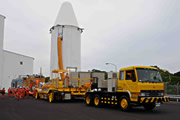
Posted by: punkboi May 10 2010, 07:17 PM
Better-quality photos of the VAB move are up
http://www.stp.isas.jaxa.jp/venus/
Posted by: colin_wilson May 11 2010, 10:59 AM
Note that the Akatsuki/Ikaros launch will be broadcast over the web, link available here : http://www.jaxa.jp/countdown/f17/live/index_e.html
Launch will be at 6:44:14 Japan time / 10:44:14 pm UK summer time / 5:44:14 pm U.S. Eastern time
Posted by: Paolo May 11 2010, 07:33 PM
Press kits:
http://www.jaxa.jp/countdown/f17/pdf/presskit_akatsuki_e.pdf
http://www.jaxa.jp/countdown/f17/pdf/presskit_ikaros_e.pdf
http://www.jaxa.jp/countdown/f17/pdf/plan_h2af17_e.pdf
Posted by: punkboi May 16 2010, 09:54 PM
Photos showing the H-2A rocket rolling out to the launch pad
Posted by: Ron Hobbs May 17 2010, 09:35 PM
I am watching the webcast. What a picturesque launch site.
Go Akatsuki!
Posted by: Ron Hobbs May 17 2010, 09:36 PM
I don't understand Japanese, but it sure looks like the weather is a problem.
Posted by: Ron Hobbs May 17 2010, 09:40 PM
Yep! The launch was just scrubbed.
Posted by: climber May 17 2010, 09:41 PM
Indeed, Scrub
Posted by: nprev May 17 2010, 09:43 PM
Bummer, but not surprising; the weather really looks nasty.
I'm kind of surprised they took it down to the wire as far as they did, really; the scrub happened at T-5 min. How long is this Venus launch window, anyhow, a week or two?
Posted by: punkboi May 17 2010, 09:45 PM
Weather forecast to be bleak for pretty much this entire week. Akatsuki / IKAROS have till June 3 to get off the ground.
Posted by: nprev May 17 2010, 09:48 PM
Read my mind, PB; I was just editing my post to ask about launch window length. ![]() Thanks!
Thanks!
Posted by: tedstryk May 17 2010, 09:50 PM
Glad they scrubbed it. Eli's exploding diaper would have caused me to miss it. Yes!!!!
Posted by: punkboi May 17 2010, 09:54 PM
The weather at Tanegashima probably won't be ideal for launch till May 25 (Tuesday). Darn.
Posted by: punkboi May 18 2010, 06:03 AM
NEW LAUNCH DATE SET: May 21 at 6:58:22 AM, Japan Time (May 20, 5:58:22 PM, EDT...or 21:58:22 UTC)
http://www.jaxa.jp/countdown/f17/topics_e.html
Posted by: brellis May 18 2010, 03:38 PM
I'd rather see a scrubbed launch than a failed launch like OCO. That was painful, watching the reactions of the team when they lost communications.
Brings to mind a question. When was the last time weather actually caused a launch failure on a significant mission?
Posted by: ugordan May 18 2010, 05:48 PM
There's the http://library.gsfc.nasa.gov/casestudies/public/GSFC-1008T-1-AC67.pdf launch. I can't think of a more recent directly weather-induced failure.
Posted by: punkboi May 21 2010, 12:42 AM
Congrats to JAXA for the successful launch of Akatsuki and IKAROS (plus those 4 smaller satellites)! ![]()
Posted by: punkboi May 22 2010, 06:08 AM
Initial Operation Result of
the Venus Climate Orbiter 'AKATSUKI'
May 21, 2010 (JST)
Japan Aerospace Exploration Agency (JAXA)
The Institute of Space and Astronautical Science (ISAS) of the Japan Aerospace Exploration Agency (JAXA) received the signal transmitted from the Venus Climate Orbiter "AKATSUKI" at the Uchinoura Space Center at 4:40 p.m. on May 21, 2010 (Japan Standard Time, JST), and confirmed that the scheduled sequence of events including the solar array paddle deployment and sun acquisition were successfully performed.
The AKATSUKI was launched from the Tanegashima Space Center at 6:58:22 a.m. on May 21, 2010 (JST)
The orbiter is currently in a healthy state.
We are preparing for the AKATSUKI injection into the Venus orbit in early December while checking functions of the onboard equipment and controlling the attitude and orbit.
We would like to express our profound appreciation for the cooperation and support of all related personnel and organizations that helped contribute to the successful launch and tracking and control operations of the AKATSUKI.
http://www.jaxa.jp/press/2010/05/20100521_akatsuki_e.html
The Operation Status of
the Small Solar Power Sail Demonstrator 'IKAROS'
May 22, 2010 (JST)
Japan Aerospace Exploration Agency (JAXA)
The Japan Aerospace Exploration Agency (JAXA) acquired the signal transmitted from the IKAROS at the Usuda Deep Space Station and confirmed its solar power generation and stable posture, and established communications. We will turn on onboard devices one by one.
http://www.jaxa.jp/press/2010/05/20100522_ikaros_e.html
Posted by: punkboi May 23 2010, 02:23 AM
'First Light' images taken of Earth with Akatsuki's LIR, UVI and IR1 instruments
Posted by: Paolo May 23 2010, 09:38 PM
some updates on Unitec http://sites.google.com/site/unitec1ops/home
Posted by: punkboi May 25 2010, 06:21 AM
IKAROS moves to Verification Experiment Phase
May 24, 2010 (JST)
Japan Aerospace Exploration Agency (JAXA)
The Japan Aerospace Exploration Agency (JAXA) completed the initial
operation check of the Small Solar Power Sail Demonstrator "IKAROS,"
which was launched on May 21, 2010 (Japan Standard Time,) from the
Tanegashima Space Center.
We will take a few weeks to carry out the first verification
experiments, namely deployment of the solar sail and solar power
generation by thin film solar cells.
This page URL:
http://www.jaxa.jp/press/2010/05/20100524_ikaros_e.html
Posted by: Paolo May 26 2010, 04:47 AM
http://sites.google.com/site/unitec1ops/updates/lateststatus26may2010300utc:
We very much appreciate if you send any reception or information for UNITEC-1.
Posted by: 4th rock from the sun May 26 2010, 10:47 AM
Here's a composite of the 3 first light images. I've added the LIR image as luminance (inverted) just for aesthetic effect.
Posted by: Stu May 26 2010, 10:58 AM
Love that, really beautiful picture.
Posted by: punkboi May 26 2010, 08:58 PM
I'm http://forum.nasaspaceflight.com/index.php?topic=18950.msg595791#msg595791 that radio contact has been lost with 3 of the 4 minisats...only Negai☆ is operating normally. That's unfortunate to hear.
Posted by: punkboi May 31 2010, 02:19 AM
IKAROS Update:
-IKAROS is 2,266,103 miles (3,646,160 km) from Earth as of today
-the spacecraft is currently spinning at 20 rpm...will increase to 25 rpm by tomorrow before the solar sail finally begins full deployment this week
http://www.isas.jaxa.jp/home/IKAROS-blog/
Posted by: punkboi May 31 2010, 06:41 PM
New images taken by IKAROS...showing the four tip masses that are on each outer tip of the solar sail have successfully separated from the spacecraft ![]()
http://www.jspec.jaxa.jp/ikaros_channel/bn004.html
As an FYI, three of those four tip masses contain many aluminum plates engraved with the names of 63,248 people. These names were submitted online as part of a public outreach effort by JAXA between December 2009 and March 22 of this year.
Posted by: Paolo May 31 2010, 06:51 PM
punkboi, it looks like we posted the same link in two separate topics
http://www.unmannedspaceflight.com/index.php?s=&showtopic=6596&view=findpost&p=160383
![]()
Posted by: punkboi Jun 2 2010, 07:03 PM
More images taken by IKAROS. http://www.isas.jaxa.jp/home/IKAROS-blog/?itemid=526 begins tomorrow ![]()
Posted by: Hungry4info Jun 2 2010, 10:25 PM
"One of the three missing minisatellites detected"
http://www.japantoday.com/category/technology/view/one-of-3-missing-mini-satellites-detected
Posted by: Paolo Jun 5 2010, 01:37 PM
This is interesting: studies have been carried out on the possibility of sending Akatsuki's secondary payloads to other targets in the solar system. It turns out Apophis can be reached
see: http://archive.ists.or.jp/upload_pdf/2008-d-43.pdf
Posted by: punkboi Jun 5 2010, 05:20 PM
I would assume that the secondary payload they're referring to is IKAROS; three of the four minisats are stuck in Earth orbit...and I don't think UNITEC-1 has any onboard propellant that would allow it to change course once it reached Venus.
Posted by: Paolo Jul 6 2010, 05:33 PM
If I understand correctly http://www.jaxa.jp/press/2010/07/20100706_akatsuki_j.html (in Japanese only) Akatsuki carried out its first 12m/s course correction on 28 June
Posted by: Paolo Oct 23 2010, 08:17 AM
JAXA has released some stellar calibration images taken earlier this month
http://www.stp.isas.jaxa.jp/venus/index.html
unfortunately, the release is in Japanese only, but the google translation is quite readable
Posted by: Paolo Nov 13 2010, 06:11 PM
two interesting-looking pages on Akatsuki telecommunications systems and antennae
http://www.nec.co.jp/ad/cosmos/akatsuki/02/?cid=twi
http://www.isas.jaxa.jp/j/column/akatsuki/06.shtml
unfortunately, they are only in Japanese for the time being...
Posted by: punkboi Nov 19 2010, 08:51 PM
Date of AKATSUKI injection to Venus orbit
http://www.jaxa.jp/countdown/f17/index_e.html
JAXA decided to emit jets from the orbital maneuvering engine (OME) of the AKATSUKI at 8:49:00 a.m. on Dec. 7 (Japan Standard Time, all the following dates and time are in JST) to inject the orbiter into the Venus orbit. Under the current schedule, the OME jet emission will be completed at 9:01:00 a.m. on the same day, and the Venus orbit will be determined around 9:00 p.m. also on the same day after some attitude control maneuvers including the Earth pointing maneuver of the Z axis.
The AKATSUKI will study the Venus atmosphere for about two years after being injected into the Venus orbit
8:49:00 a.m. on Dec. 7 JST (11:49:00 p.m. on Dec. 6 UTC)
****
What I'm wondering is when Akatsuki will start taking images of Venus as the spacecraft nears arrival...and when JAXA will release 'em ![]()
Posted by: rlorenz Nov 25 2010, 02:16 PM
I don't know the details of science operations : the JAXA team is understandably focussed on
getting safely into orbit first. NASA did just announce (although oddly not yet linked on
the NASA or JAXA Akatsuki pages, as far as I can tell) the selection of US-supported
participating scientists for Akatsuki. Among their (our) tasks will be to assist with archiving the
data in a PDS-consistent format and with Education/Public Outreach efforts....
http://www.jpl.nasa.gov/news/news.cfm?release=2010-389
Posted by: Paolo Nov 25 2010, 05:52 PM
from the latest ESA bulletin (published online yesterday http://www.esa.int/esaCP/SEMO6LIRPGG_index_0.html )
and Venus Express will start in January 2011 and will cover a large number of different cases, including simultaneous observations at different scales, differential radio science
observations, long-term chained tracking of cloud patterns, spectral versus large-scale imaging observations and cross-calibration. Several of these observations will
also be coordinated with observers at a number of the world’s leading ground-based observing facilities.
Posted by: punkboi Dec 6 2010, 01:14 AM
AKATSUKI ready for orbit injection
The Venus Climate Orbiter "AKATSUKI" shifted its attitude at 7:50 a.m. on December 6 to be ready for Venus orbit insertion at 8:49 a.m. on December 7.
On the 7th, we will hold some events to support the AKATSUKI orbit injection. We plan to run the "Venus arrival live broadcast" featuring the AKTSUKI and show the scene of the AKATSUKI Control Room" at a public viewing site. Please come and join the injection moment. (* All time and dates are Japan Standard Time.)
http://www.jaxa.jp/countdown/f17/topics_e.html
Posted by: Hungry4info Dec 6 2010, 10:01 PM
Something has started http://www.yac-j.or.jp/tv/popup_setv_stickam_main.html. Akatsuki-related?
Posted by: Ron Hobbs Dec 6 2010, 10:03 PM
A little less than 2 hrs to go.
Go, Akatsuki!
Posted by: Hungry4info Dec 6 2010, 10:09 PM
From their twitter:
"[From Akatsuki Team] For Orbit insertion forty-nine past eleven p.m. Burn at UT, we confirmed Have LATCH Valve is opened."
Posted by: Paolo Dec 6 2010, 10:30 PM
Just for statistics: if successful, Akatsuki will become the eighth Venus orbiter, after 4 Soviet ones, 2 US and 1 European.
Remarkably, no Venus orbiter has ever failed before reaching the planet, unlike the many (10) lost Mars orbiters
Posted by: punkboi Dec 6 2010, 10:56 PM
Akatsuki begins its orbit insertion burn around Venus in less than an hour. Hopefully everything goes smooth! ![]()
Posted by: Hungry4info Dec 6 2010, 11:19 PM
There is now audio on the stream.
Posted by: Ron Hobbs Dec 6 2010, 11:57 PM
Aargh! I can't get the stream here at work. Is the burn going OK?
Posted by: Hungry4info Dec 7 2010, 12:00 AM
I'm getting a stream but it's extremely choppy. There's no English translation available but there has been a couple episodes of clapping.
Posted by: Ron Hobbs Dec 7 2010, 12:11 AM
Well the burn should be over now. We'll just assume that the clapping is a good sign that Akatsuki is now a satellite of Venus.
Posted by: Hungry4info Dec 7 2010, 12:12 AM
They should be coming out of comm blackout now.
We'll know soon.
Posted by: nprev Dec 7 2010, 12:13 AM
Hungry, are you using the same link you posted for the stream? I can't get it to load at all.
Posted by: Hungry4info Dec 7 2010, 12:18 AM
Yes.
They were supposed to regain contact with the spacecraft seven minutes ago. I haven't seen any applause or cheering (though granted the stream does suck.)
Posted by: nprev Dec 7 2010, 12:25 AM
Ah--thanks. Looking forward to updates, will watch this topic closely...looks like it'll be the only near-RT info source available in English.
Posted by: Hungry4info Dec 7 2010, 12:30 AM
Afraid there's not much to say at the moment...
A lot of people looking at their monitors. Others looking at graphs projected onto the wall. No one looks particularly amused.
Posted by: Hungry4info Dec 7 2010, 12:32 AM
May have heard some clapping. (again, with the way the feed is, it's really hard to make things out)
Posted by: Sunspot Dec 7 2010, 12:32 AM
Shouldn't we have heard something by now?
Posted by: Hungry4info Dec 7 2010, 12:33 AM
I don't know what this is but it is being presented to the viewers.
Posted by: Sunspot Dec 7 2010, 12:35 AM
aahhh haaaa the stream is working
Kind of lol
Posted by: Hungry4info Dec 7 2010, 12:40 AM
If his pen marks the position of the spacecraft, they may have made it.
Posted by: nprev Dec 7 2010, 12:42 AM
Blast and damn, I can't get the stream to work!!! ![]()
Oh, well. My wife's out shopping anyhow...hopefully she'll be home soon for some translation duty...
Posted by: Hungry4info Dec 7 2010, 12:45 AM
They showed a visually impressive demonstration of a cup being crushed in a pressure chamber. The cup had solar arrays marked on it.
May have heard some clapping, too.
Posted by: punkboi Dec 7 2010, 12:48 AM
Communications currently interrupted with the spacecraft since its antenna is facing away from Earth.
We shouldn't officially get an update on Akatsuki's current orbital position till 4 AM, PST (7 AM, EST) ![]()
http://twitter.com/Akatsuki_JAXA
Posted by: Hungry4info Dec 7 2010, 12:51 AM
That's a comforting explanation.
Posted by: Sunspot Dec 7 2010, 12:52 AM
The twitter feed hasnt been updated for an hour.
Posted by: Hungry4info Dec 7 2010, 01:02 AM
A significant amount of clapping... probably because the feed just ended.
Looks like it was just applauding the end of the show.
Edit: Though feed from the control room remains.
Posted by: nprev Dec 7 2010, 01:11 AM
My wife's translation of the sign: "Akatsuki presents key word!"
Interpretation: She chirped an "I'm okay" signal? ![]()
Posted by: Hungry4info Dec 7 2010, 01:14 AM
My sincerest thanks for your wife's translations.
I like your interpretation, I hope it's true. =)
Posted by: nprev Dec 7 2010, 01:19 AM
She said "you're welcome". ![]()
The language barrier just makes the uncertainty worse, of course, but I don't think that they would have shown that sign unless things were not nearly as black as they seemed awhile back. We don't know if everything is nominal--based on what you wrote, doesn't seem like it--but it looks like Akatsuki is still in the game.
Now to wait some more to see if she made orbit, I guess...
Posted by: marsbug Dec 7 2010, 01:19 AM
So do I - I have to get to bed....good luck Akatsuki!
Posted by: Ron Hobbs Dec 7 2010, 01:19 AM
Me too! I've got my fingers crossed.
Posted by: Bjorn Jonsson Dec 7 2010, 01:23 AM
I really should have gone to bed some time ago but simply couldn't due to this event. We have obviously gotten used to following events like this in real time without any problems. Hopefully everything is OK.
Posted by: Hungry4info Dec 7 2010, 01:27 AM
Finally, new tweets at Akatsuki_JAXA (http://twitter.com/akatsuki_jaxa)
Edit: ...after being passed through Google translator.
Posted by: punkboi Dec 7 2010, 01:31 AM
Emily posted a helpful chart showing the timeline of events after the orbit insertion burn
http://www.planetary.org/blog/article/00002802/
Posted by: Hungry4info Dec 7 2010, 01:32 AM
From http://twitter.com/cosmos4u:
Edit: From the same source:
Posted by: Hungry4info Dec 7 2010, 01:39 AM
http://translate.googleusercontent.com/translate_c?hl=de&ie=UTF-8&sl=ja&tl=en&u=http://twitter.com/koumeiShibata&prev=_t&rurl=translate.google.com&twu=1&usg=ALkJrhg4VYcH9ax9r4eSYWC-DKRv-4Ih8g (a translated twitter...) shows some interesting tweets.
Posted by: punkboi Dec 7 2010, 02:04 AM
New Tweet from @Akatsuki_JAXA: [More] Sagamihara operation room about 28 minutes at 10 December 07, 2010 (Japan time), and received a wave from the Akatsuki. Currently, we went to check the state of the satellite.
Posted by: nprev Dec 7 2010, 02:05 AM
My wife's translation of the most recent tweet from http://twitter.com/akatsuki_jaxa (10 min ago as I write this):
'As of 7 Dec 2010 1028 JST received signal from Akatsuki. We are attempting to verify its position (attitude?)."
She said it 'came from Mission Control'.
Posted by: Ron Hobbs Dec 7 2010, 04:36 AM
Spaceflight Now is reporting the http://www.spaceflightnow.com/news/n1012/06akatsuki/
The good news: "Engineers confirmed ignition of the thruster before Akatsuki passed behind Venus" ![]()
"Controllers finally received signals from the spacecraft at 0128 GMT Tuesday (8:28 p.m. EST), or at 10:28 a.m. Japanese time."
I hope to hear that Akatsuki is safely in Venusian orbit tomorrow morning. Have a good night all.
Posted by: Hungry4info Dec 7 2010, 04:51 AM
Indeed, same from cosmos4u.
Posted by: punkboi Dec 7 2010, 05:29 AM
http://translate.googleusercontent.com/translate_c?hl=de&ie=UTF-8&sl=ja&tl=en&u=http://twitter.com/koumeiShibata&prev=_t&rurl=translate.google.com&usg=ALkJrhhNrw7BvstntBEzJHc7alk-6Pm9gA ![]()
--Akatsuki ending press conference. No announcement of the meeting until 22:00 and there are reports point out trouble, and it brought back to confirm. It is going to be a long war.
--Akatsuki is unknown or has failed. Gain antenna was in use until now.
Posted by: nprev Dec 7 2010, 05:35 AM
PB, do you have the link to the original Japanese versions of those tweets?
Posted by: Hungry4info Dec 7 2010, 05:36 AM
http://twitter.com/koumeishibata
Posted by: punkboi Dec 7 2010, 05:37 AM
EDIT: Nevermind, Hungry beat me to it
Posted by: nprev Dec 7 2010, 05:46 AM
Der. I should've figured that out on my own, huh? Thanks, you guys!
Kay just looked it over, and it's as you said: Q&A with a lot of "we don't knows". Does sound like they're expecting to slowly get some data down over the LGA; the data rate must be pretty slow.
She also says that they lost contact "briefly" before the orbital injection maneuver, but they expect to regain contact "tomorrow"; no time given, but I guess Emily's timeline can probably help to determine that.
Posted by: Hungry4info Dec 7 2010, 07:24 AM
From Akatsuki_JAXA
Posted by: Paolo Dec 7 2010, 08:26 AM
while awaiting for some news, thehttp://www.stp.isas.jaxa.jp/venus/ posted some nice distant images of Earth and Moon taken, if I understand correctly, last 26 October, by the many cameras on the probe.
Posted by: ngunn Dec 7 2010, 11:03 AM
Not sure if this adds anything to info already posted but at least it's easy to read: http://www.google.co.uk/url?sa=t&source=news&cd=1&ved=0CCQQqQIwAA&url=http%3A%2F%2Fmdn.mainichi.jp%2Fmdnnews%2Fnews%2F20101207p2a00m0na004000c.html&ei=GxT-TOeUIMHJhAfbp9mfCw&usg=AFQjCNF-HR0sLY_N444cZQCqrdmqAOpQnQ
Posted by: marsbug Dec 7 2010, 01:46 PM
The impression i'm getting from the various tweets and blogs is that they've established some kind of communication with the craft through its low gain antenna. The orbit and inclination seem to be unknowns at the moment, there may be a problem with the crafts rotation ( which should be about an axis going through the thruster and the high gain antenna) that is preventing the high gain antenna from being used. Basically shes alive but they don't yet know where or what shape she's in.
Anyone getting anything radically different?
I hope this is another hayabusa where they pull it back.
Posted by: marsbug Dec 7 2010, 02:05 PM
http://translate.googleusercontent.com/translate_c?hl=de&ie=UTF-8&sl=ja&tl=en&u=http://twitter.com/koumeiShibata&prev=_t&rurl=translate.google.com&usg=ALkJrhhsTUq4q6lPglk1wXr8yqkuBmRsag seems to be reporting an interview with project manager Nakamura. Its hard to make out but he seems to be saying that they need to work out where the craft ASAP as tomorrow would be too late to perform a course correction if its needed.
Posted by: marsbug Dec 7 2010, 02:22 PM
From the above link:
Press conference at 2400 japan time? Thats about 45 minutes if thats what it means. Don't know what the SAC team is or whether them preparing to withdraw is a good or bad sign.
Having quit smoking I can say withdrawal is generaly unpleasant but nescecary! (attempt at humour!)
Posted by: nprev Dec 7 2010, 04:46 PM
My wife just looked over the latest tweets, and nothing of note said; mostly admin stuff about a press briefing at midnight (which apparently already occurred, but no summary posted there.) The SAC team (whoever they are) was preparing for a comm pass, apparently; there was some reference to a "download".
Posted by: elakdawalla Dec 7 2010, 05:16 PM
Nick, if Kay is available, it would be lovely to get a translation of this press release, which is in PDF format: http://is.gd/ilHmw
Posted by: nprev Dec 7 2010, 05:30 PM
Good timing; she was right here! Here it is, with her disclaimer that she's not a space enthusiast so may not have the terminology down pat (any interpolation is mine, and therefore also any errors):
Akatsuki Status
On 7 Dec at 1028 JST the mission team received a signal, but after analysis it was verified that the spacecraft was in safe mode.
The team will determine the spacecraft's position and status as soon as possible and continue tracking.
Posted by: peter59 Dec 7 2010, 05:50 PM
KYODO NEWS - JAXA unable to confirm space probe Akatsuki has entered Venus orbit
The Japan Aerospace Exploration Agency said Tuesday evening that it has yet to confirm whether the space probe Akatsuki has successfully entered orbit around Venus due to communication problems after it reversed its engine in the final step.
But the Japanese space agency said that Akatsuki has presumably retained its normal posture to secure electricity by automatically switching to a mode of holding its solar battery panel toward the sun.
''We were able to figure out the movements of its radio waves and that is a big step. There is still hope,'' Seiichi Sakamoto, professor of the JAXA's Institute of Space and Astronautical Science, said.
So there is still hope. ![]()
Posted by: nprev Dec 7 2010, 06:11 PM
Emily's got the http://www.planetary.org/blog/article/00002806/. The spacecraft is safed, communicating slowly due to some limiting circumstances, orbital status still unknown; see her article.
Posted by: djellison Dec 7 2010, 07:19 PM
If they're only getting 40s per 10 mins - that would explain the difficulty in getting the tracking data required to figure out the orbit. It takes a while to lock up on a signal and figure out the doppler etc
Posted by: Hungry4info Dec 8 2010, 01:58 AM
Apparently, a JAXA news conference is about to begin. I don't know where to follow it.
Edit: Can follow here (Translated); http://translate.googleusercontent.com/translate_c?hl=de&ie=UTF-8&sl=ja&tl=en&u=http://twitter.com/koumeiShibata&prev=_t&rurl=translate.google.com&twu=1&usg=ALkJrhg4VYcH9ax9r4eSYWC-DKRv-4Ih8g.
Posted by: Hungry4info Dec 8 2010, 02:11 AM
Posted by: punkboi Dec 8 2010, 02:15 AM
It's Nozomi all over again... ![]()
Posted by: Explorer1 Dec 8 2010, 02:24 AM
My thoughts exactly, but as long as the orbit crosses (and they have enough fuel), they can in theory try again, right? Hopefully without a nasty solar storm like Nozomi experienced...
Posted by: Hungry4info Dec 8 2010, 02:25 AM
Wow much better source
http://translate.googleusercontent.com/translate_c?hl=de&ie=UTF-8&sl=ja&tl=en&u=http://twitter.com/ots_min&prev=_t&rurl=translate.google.com&twu=1&usg=ALkJrhiYRPT61Lt7qEr7kzkUkaix-vLJhw.
Posted by: elakdawalla Dec 8 2010, 06:29 AM
I wonder what, if anything, they can do with the spacecraft in the intervening time. Search for NEOs? I hope the spacecraft is in good health. I haven't seen any detail yet on what exactly went wrong, if they know anything about that yet.
Posted by: Hungry4info Dec 8 2010, 06:32 AM
From cosmos4u's twitter
Posted by: Explorer1 Dec 8 2010, 06:35 AM
A strange anecdote:
It was just a couple of days ago when I saw the new issue of Astronomy magazine on a rack in a store, so I flipped through and saw an article (by Jim Oberg I think?) actually mention Akastsuki and how it would be in orbiting Venus (the issue is for the new year), and I thought to myself 'Well they haven't actually gotten into orbit yet, they're a bit ahead of themselves; something could still go wrong'.
And sure enough, it did! :0
Hopefully I didn't jinx them? Even double by mentioning a solar storm?
Posted by: eoincampbell Dec 8 2010, 06:40 AM
Thank you all for pointing us to the blogs and news today,
I really feel for the JAXA team and wish them all the best with their contingency plan...
Posted by: ZLD Dec 8 2010, 07:20 AM
I don't mean to be too critical because space exploration is still rather new and the level of accuracy needed to have a successful mission is almost ridiculous, but this seems to be a continuing pattern with JAXA. They seem to have incredible ideas for missions but I have to wonder if they are being greatly underfunded or if they maybe just need better management/oversight. NASA has had its fair share of screw-ups too (Mars Surveyor '98 anyone?) but they tended to be single events surrounded by other very successful missions. It is entirely amazing that being a very new space agency that they've had so many successfully lifted and operated spacecraft but the previous two interplanetary missions have had serious complications that compromise their intended objectives; Nozomi, being still under the NSDA in 1998 can be lumped in as well. It is greatly disappointing to read of these issues. Heres to hoping they somehow miscalculated the beacon and only suspect that the orbital insertion failed. ![]()
I guess lets look forward to some pictures of Venus from http://en.wikipedia.org/wiki/UNITEC-1 in the near future.
Posted by: Paolo Dec 8 2010, 07:47 AM
Shin'en failed the day after launch.
My idea is that the tried to cut some corner on former-ISAS missions (Nozomi, Hayabusa, Lunar-A that eventually did not fly, and now Akatsuki). Maybe it is a question of budget, lack of oversight, or lack of testing... On the other hand, missions managed by the former NASDA have been quite successful. Think of Kaguya
Posted by: nprev Dec 8 2010, 08:31 AM
Failures happen in space exploration. It's an ugly truth, and of course there has been tremendous progress over the past 53 years...but they happen, and they always, always will.
Failure modes are often complex, subtle, unexpected, obvious, avoidable, unforeseeable, unimaginable...pick any or all of the above. There are hard limits to pre-launch testing, and nobody and nothing can test all possible cases, or even identify them...we can't know each & every "what-if", nor quite frankly could we test for them all due to the hardest constraints of all--time & money--even if we could know. And sometimes things that in hindsight should have been obvious are simply missed because that is a human characteristic.
It just happens, people.
In that light, I suggest that we be as supportive as we can of the Akatsuki team & JAXA. This is a terribly difficult time for them, both as organizations and as individuals. Whatever disappointment we all feel right now isn't a thousandth of what they feel, and I am certain that each person involved is running through an endless, painful series of what-ifs & coulda/shoulda/wouldas.
We don't need to add to that already terribly heavy burden.
What happens next? Learning. Not the learning about Venus they anticipated to be sure, but learning about spaceships & processes. That's arguably just as valuable in the long run, and perhaps even more so; Venus isn't going anywhere.
But we are. ![]()
Posted by: antipode Dec 8 2010, 11:34 AM
I'm a little confused here. Did the braking engine fire at all? If they don't have doppler data how can they be planning a second try in 7 years, or is that based on the assumption that there was no deltaV?
P
Posted by: marsbug Dec 8 2010, 12:07 PM
Assuming the craft is healthy, aside from whatever caused the engine failiure, is there any hope of recycling the craft as in Deep Impact/EPOXI? 7 years is a long time to do nothing even if they think they can get it into Venusian orbit at that time. But even if they don't think they can make a venus orbit it seems a shame to throw a healthy spacecraft away.
Posted by: Stu Dec 8 2010, 12:51 PM
But we are.
I swear I heard the Star Trek theme fanfare when I read that last line, Nick.
Well said.
Posted by: MahFL Dec 8 2010, 12:54 PM
Not 100 % healthy though, as it did not make orbit.....
Posted by: tolis Dec 8 2010, 01:43 PM
My twopence, for what it's worth:
It's not quite Nozomi. Nozomi's engine malfunctioned on the way out of the Earth-moon system.
This is more like what happened during the first encounter between the NEAR spacecraft and
asteroid 433 Eros back in 1998. In this case, unfortunately, the planet's significant gravity
means that they can't just "back it up". Planetary orbit insertions are really make-or-break
(or "brake-or-break?) events.
However, there may still be a significant silver lining in that cloud. As I understand it, the orbit is now
Venus-like, a very good vantage point to observe asteroids, comets and zodiacal dust, the latter already a cruise-phase target.
The array of cameras onboard is suitable for the task (UV, visible, NIR and FIR).
The objects themselves would be hotter than at the Earth's orbital distance from the sun (asteroids)
and, for the same reason, exhibit higher levels of activity (comets). Simultaneous observations
from the Earth and from akatsuki would be useful in determining the three-dmensional structure of
cometary comas and tails. In addition, new objects in intra-Earth orbits, such as Venus Trojans, could be discovered.
There is a lot to do. In fact, and if i may be so bold, I expect the mission team to be considering these very possibilities as we speak.
Tolis.
Posted by: marsbug Dec 8 2010, 02:29 PM
I wonder, is it possible that usefull observations of Venus could still be made? Long term monitoring of the infra red spectrum of Venus might be usefull in support of Venus Express, even if Venus only appears as a single pixel to the instrument?
I'm actually looking forward to hearing what they may come up with. I really hope there is still a usefull mission to perform. If the team can deliver a scientificaly compelling mission for Akatsuki on its current orbit they may turn tuesday/wedensdays disaster into a 'finest hour' moment.
Posted by: ilbasso Dec 8 2010, 02:33 PM
Given JAXA's success with Hayabusa, I wouldn't be surprised that in the intervening 6-7 years, the engineers reconfigure Akatsuki into a Venus atmosphere probe, sample the Venusian atmosphere, arrange a rendezvous with the solar sail, and use it to return the sample to Earth! ![]()
It is an extraordinarily complex business. The ratio of all nations' failed interplanetary probes to the number of successful ones is still quite high, despite 50 years of experience. We have been spoiled by those few probes that have worked and then continued on into extended missions.
Posted by: dtolman Dec 8 2010, 03:11 PM
Out of genuine curiosity - is there some major difference in the mission management of NASA & ESA, versus the Japanese agency?
Perhaps it is the small sample size, but it seems they haven't been able to a launch any missions the past decade that don't have some serious problem. Do they lack the budget to simulate as many scenarios as NASA/ESA? Don't have as vigorous testing of components? Just plain lack of experience?
At this point, with this history of failures, I have to think that these aren't isolated incidences and they are missing some critical ingredient that NASA & ESA just get right - but I don't have any idea what it could be...
Posted by: djellison Dec 8 2010, 03:56 PM
Nor is anyone here going to have an idea what it could be - and speculation of that nature is a best guessing and at worst, just down right unhelpful.
I would encourage all to carefully read http://www.unmannedspaceflight.com/index.php?showtopic=6508&view=findpost&p=167629 - Nick got it just right.
Posted by: Explorer1 Dec 8 2010, 06:44 PM
The Americans and Russians didn't give up in the 50s, 60s, and 70s, why should Japan give up now?
Keep trying JAXA! Every 'failure' = more experience. That's what counts in this business.
Posted by: deglr6328 Dec 8 2010, 08:02 PM
I would be very interested to see the results of a survey regarding support for space exploration by the Japanese public and how it has or has not changed over time. We know these numbers with http://www.gallup.com/poll/121736/majority-americans-say-space-program-costs-justified.aspx in the American public, but I find it very difficult to gauge the feelings of the Japanese on these issues.
Posted by: nprev Dec 8 2010, 11:44 PM
Emily has another http://www.planetary.org/blog/article/00002811/ covering today's statements by JAXA. It looks like attempting to reach Venus orbit in late 2016 is in fact being considered; 80% fuel remains!
Posted by: belleraphon1 Dec 9 2010, 12:26 AM
The space business is tough. Not for the faint of heart nor the impatient. Look what JAXA did with Hayabusa.... brought her home with payload.
In the 60's an incident like this would have written off the misson. NOW, we can expect missions to recoup themselves, givern time and patience.
My heart goes out to JAXA. Persevere and learn. You do great work.
Craig
Posted by: Enceladus75 Dec 9 2010, 12:58 AM
It's very disappointing. ![]() JAXA seem to have a very poor rate of success for their interplanetary space missions. Hopefully they'll be able to refocus the mission to salvage what they can.
JAXA seem to have a very poor rate of success for their interplanetary space missions. Hopefully they'll be able to refocus the mission to salvage what they can.
Posted by: spdf Dec 9 2010, 03:17 AM
Their failure rate is quite low. Their last failure in the science programm was in 2000 when the Astro-E astronomy mission got lost during launch. The only failure in the 1990s was Nozomi. Except for these two all the missions were successful to very successful. Some things got lost in translation between English and Japanese, if I remember it correct this was the reason why Astro-EII lost one of its instruments. But still the mission is producing results. Solar-B lost its x-band downlink, so they had to include more ground stations. Reimei, Akari, SELENE, IKAROS, Hayabusa ... did (or are still doing) a great job.
Posted by: ElkGroveDan Dec 9 2010, 04:26 AM
Hayabusa eventually achieved it's goal, and we all admire the skill of the JAXA engineers for bringing the crippled craft home, but let's be realistic. It WAS a crippled craft and the mission was plagued with one crisis after another. The brilliant solutions for adapting and working around these failures brought Hayabusa back from near death more than a few times.
That said, I don't think there is a pattern in any of this and as far as I'm concerned the Japanese Space program is to be applauded.
Posted by: spdf Dec 9 2010, 04:50 AM
But since noone tried this stunt before, and noone knew before how the asteroid looked like, I think it might have been inevitable that Hayabusa became crippled.
Here are some of the lessons learned from Hayabusa:
http://sci2.esa.int/Conferences/MarcoPolo-ws08/Progress_of_the_japanese_team_-_Hajime_Yano.pdf
Posted by: ElkGroveDan Dec 9 2010, 05:06 AM
I agree with you. But you still can't pretend that it was a smooth, successful mission.
Posted by: stevesliva Dec 9 2010, 05:08 AM
It seems to me Japan is really pushing the technology pretty hard. It's worth pointing out that since Nozomi launched, CONTOUR blew up, MCO cratered, MPL cratered, Beagle cratered, Genesis cratered, Chandrayaan-1 failed, MGS failed... eh, sh*t happens. I do agree Hayabusa had a lot of it.
Posted by: antipode Dec 9 2010, 07:54 AM
Having 80% of your fuel left might not mean much if you cant use it to enter orbit. Lets hope we learn more about why the burn terminated early and what, if anything can be done to make sure it doesn't happen again should the craft survive another 6 years.
p
Posted by: nprev Dec 9 2010, 08:02 AM
Well, one way to look at it is that six years is a great deal of time to try to determine the exact cause(s) of the fault. I'm sure that it will take much less time than that, though.
In the meantime, I would guess that their priority will be to try to find a way to keep Akatsuki healthy with a minimal expenditure of fuel. Towards that end, I wonder if they can use the arrays for solar-sailing-style attitude control, or perhaps even to modify the trajectory to reduce the amount of fuel needed for the next attempt to achieve Venus orbit?
Posted by: pandaneko Dec 9 2010, 08:53 AM
I think I might tell something from the press here. Those JAXA(ISAS) crafts are too small. Hayabusa, for instance
, had to be launched by an M5 solid fuel rocket. Alatsuki had also been designed to go on the same small M5 rocket, before IASA was merged with JAXA.
No redundancy, whatsoever, unlike NASA, ESA, Russian space probes. So, I am not surprised at all. One newspaper here says that AKATSUKI may have collied with something in flight!
Pandaneko (Am I still wanted?)
Posted by: Paolo Dec 9 2010, 10:14 AM
the best way to reduce the size of the course correction needed to reach Venus would be to make it as soon as possible. Of course, if the thruster is the main suspect for the missed orbit, the correction won't be any time soon
Posted by: ngunn Dec 9 2010, 10:42 AM
I really like Nick's solar sailing suggestion. I'd love to see some order of magnitude figures on how much could be achieved that way over 6 years. It's something that could be started without waiting for the full diagnosis and (hopefully) correction of the engine problem.
Posted by: spdf Dec 9 2010, 01:59 PM
Sorry, I did not want to pretend it was a smooth mission. But in the end they got what they paid for. Nevermind.
Here is some information about the thruster on Akatsuki. If this was the cause than puting it into orbit in 6 years might be impossible.
http://mdn.mainichi.jp/mdnnews/news/20101209p2a00m0na006000c.html
Posted by: stevesliva Dec 9 2010, 05:10 PM
Pandaneko (Am I still wanted?)
Yes!
I'd read the last article above as implying that the thruster may have had undetected damage on the ground, or from launch.
Posted by: Enceladus75 Dec 9 2010, 05:50 PM
Didn't Hyabusa and Nozomi also both suffer from thruster problems?
There must be some inherent flaw in the design of the JAXA interplanetary spacecraft - no matter what positive angle people want to put onto it. Hyabusa returned home to Earth through nothing short of a series of miracles and of course I'm very glad it did and it was testament to the skill and ingenuity of JAXA mission specialists, but to have your first probe to Mars and then your first to Venus both fail to insert into orbit must be a disappointment and shows that something could be wrong with the thruster systems and needs to be addressed.
It's better to be honest about any potential problems with the spacecraft and learn from these.
Posted by: djellison Dec 9 2010, 05:54 PM
No one here is suitable qualified to make such a judgement.
Posted by: ElkGroveDan Dec 9 2010, 06:06 PM
You could say the same thing about NASA, and I hope I don't need to list the failures here. You could even say the same thing about American automobiles up to the 1930's or 40's. Engines used to seize, axels would break, tires would blow out for no apparent reason and many people died horrible deaths as a result. But thanks to years of trial and error and many millions of vehicles tested, automobile engineering evolved to where it is today -- very complicated and very precise on everything from the composition of metals to the placement of the center of gravity and the layers of glass in the windshield.
Space science is still relatively new with respect to the number of vehicles built and operated. We'll all get there eventually after lots of trial and error.
Posted by: Enceladus75 Dec 9 2010, 06:08 PM
True, but surely a degree of speculation as to what may have caused the problems with Atasuki is warranted. The evidence so far points to a dificulty with the thrusters. Didn't Hyabusa and Nozomi both also have thruster problems?
Posted by: djellison Dec 9 2010, 06:13 PM
Umm - to be honest, no.
Posted by: Enceladus75 Dec 9 2010, 06:14 PM
Yes of course there is a learning curve involved. That must mean learning from the failures and problems as much as from the successes. JAXA will no doubt learn from the failure of Atasuki just as the other space agencies learned from their own mission failures.
Posted by: Holder of the Two Leashes Dec 9 2010, 06:17 PM
Yes, you are.
We don't know it was a thruster problem at all yet. Could be a collision (they seem to think it's a possibility, with more info than we have). Could be software. Could be something else.
Even if it is a thruster problem, why think it necessarily has anything in common with Nozomi? This was an innovative ceramic design, first operational flight. Could be they were trying something new in order to address problems they were having.
If there has been thruster damage, and it is stable and not too serious, then there is no reason to give up hope. A little bit of lateral thrust could be offset by spinning the craft around the main thrust axis while firing in order to distribute (and cancel) the error.
Again, no one knows yet. Give JAXA a little time to figure things out.
Posted by: tasp Dec 9 2010, 06:30 PM
6 years is a long time to be tootling around the inner solar system. We might get lucky and have a comet whiz by for some nice impromptu science. Or maybe Akatsuki gets close to Toro, or Aten, or Cruithne. I'm sure they are crunching the orbits to see if we can get in a little side trip on the way back to Venus.
Posted by: tedstryk Dec 9 2010, 07:45 PM
Putting MGS, a spacecraft that was seven or eight years past its warranty, in that category doesn't fit.
Posted by: stevesliva Dec 9 2010, 07:54 PM
I debated that, but it was a commanding error, IIRC. That the devil is in the details is sort of the point, though. You take these things on a case-by-case basis and it's hard to point the finger at some overarching root cause that's being missed.
Posted by: Julius Dec 9 2010, 09:13 PM
I am very disappointed as a space enthusiast ,its a great loss for JAXA and the space community.Venus is in dire need of further exploration and this failure is a big setback.But keep on trying...space exploration is not all about success.
Posted by: deglr6328 Dec 9 2010, 09:53 PM
An unexpected 6 years wouldn't be an obviously insurmountable additional cruise time for a modern space probe....that ISN'T in orbit at 0.7 AU through solar max.
Posted by: Holder of the Two Leashes Dec 9 2010, 11:12 PM
A small, relatively cheap probe named MESSENGER is spending an extra two years over what was originally planned in a much worse solar environment. This due to reschedueling its launch date. It seems to be doing fine at the moment.
Nobody in Japan that I've heard of is raising this as an issue, other than some concerns about keeping the craft in a cool enough attitude.
Seem to recall that MESSENGER had a safing event near a close approach, too ...
Posted by: nprev Dec 10 2010, 01:54 AM
More http://www.planetary.org/blog/article/00002814/ from Emily: a three-axis attitude plot during the burn.
Re the collision possibility: I've been trying to wrap my head around the likelihood of this. Would have had to have been a real 'Goldilocks Rock' if it was a natural object: it hit at just a low enough relative velocity & with just enough mass to peturb the spacecraft & not utterly destroy it (which presumably would have been a far more likely outcome, statistically speaking).
Unless they're thinking that Akatsuki somehow collided with something that had already fallen off of the spacecraft itself, I think that the news reports may have been taking a piece of standard blue-sky idea generation for troubleshooting out of context.
Posted by: Holder of the Two Leashes Dec 10 2010, 04:43 AM
You're right that it's a statistical near zero. Magellan and many other spacecraft have orbited Venus for years with no such encounters that I'm aware of. The only precedent I can think of off the top of my head is Mariner 4 (while it was nowhere near Mars). But we can't really rule out anything at this point, no matter how unlikely. Mariner and Giotto both showed that being knocked for a loop by a high speed impact was a more likely outcome than destruction.
Having said that, well... realistically, it was something with the spacecraft.
Posted by: elakdawalla Dec 10 2010, 05:27 AM
God this photo is sad. Venus, 600,000 km away and getting farther every second.
I look forward to help from pandaneko and spdf and other Japanese-speaking forum members on what was said at today's press briefing; I've got a bunch of links in my http://www.planetary.org/blog/article/00002817/ but am not getting a lot of sense out of the Google translations.
Posted by: peter59 Dec 10 2010, 11:28 AM
Akatsuki's fuel pressure plunged before failure to enter Venus orbit.
http://mdn.mainichi.jp/mdnnews/news/20101210p2a00m0na010000c.html
Posted by: tedstryk Dec 10 2010, 01:02 PM
Is that a double exposure or is their a high haze layer beyond the upper limb?
Posted by: pandaneko Dec 10 2010, 01:03 PM
JAXA have examined the records, fuel flow and engine temp etc etc. As a result, they found that fuel pressure started drecreasing immediately after the retro started. The power dropped accordingly.
Heilum gas was supposed to maintain the tank pressure, but it did not. The same thing happned with NOZOMI in 1998. They suspect design faults with the pipings and valves.
So, my guess is that all the hope has been lost for another try in 6 years.
Pandaneko
Posted by: 4th rock from the sun Dec 10 2010, 05:02 PM
Here's a color composite of the 3 distant images (UV1, IR1 and LIR).
It's very unfortunate that the spacecraft is not in orbit...
Some haze layer seems to be present on the IR1 image, but I'd expect that on the UV1. It might be a double exposure.
Posted by: tasp Dec 10 2010, 06:35 PM
Thanks Pandaneko, your work and reports are very much appreciated, even when the news is unfortunate.
I'm just speculating, but if the engine might function 'normally' for brief periods, then JAXA would have considerable DeltaV for Akatsuki, just with some serious constraints on how that DeltaV is used. Since the craft appears otherwise healthy, there might be some good solid science to be done. If the engine can't do 'one big burn' to enter a planetary orbit, there might yet be other targets reachable with a series of small burns.
Just some quick and dirty possibilities to consider;
* Aten class asteroid observations
* station the craft in the Venusian L1 or L2 points for long term observation
* long term solar wind study (if the craft is instrumented appropriately) with the upcoming solar maximum, this might be a unique opportunity
* if the current orbit approaches earth eventually, a gravity deflection to somewhere else might be possible. The options for that might be surprising.
* comet studies
* if orbiting Venus is not possible in 6 years, a gravitational deflection during that flyby would also increase the options for salvaging a mission
* what was the largest engine burn NEAR executed at Eros? If Akatsuki retains that much capability for maneuvering, then knowing just how creative and capable the JAXA folks are, there might be some really incredible, but unfortunately, unVenusian, mission options.
Posted by: Paolo Dec 10 2010, 08:11 PM
the problem with propellant pressure and thruster misfire was not what doomed Nozomi. Nozomi was crippled by a series of hardware failures and mishaps in the years it spent orbiting the Sun. It lost most of its capabilities to communicate with Earth as well as thermal control, which let hydrazine freeze.
Hopefully the same will not happen to Akatsuki.
Still, I can't see the link between the pressure loss and asymmetric thrust and spin
Posted by: tedstryk Dec 10 2010, 08:18 PM
Hopefully the same will not happen to Akatsuki.
Still, I can't see the link between the pressure loss and asymmetric thrust and spin
I think people were thinking of the fact that Nozomi achieved insufficient velocity when leaving the Earth-Moon system, which is why it was not already orbiting Mars when it was crippled by those mishaps.
Posted by: rlorenz Dec 11 2010, 02:59 AM
Right. Nozomi's propulsion system underperformed during its departure burn (weak propellant
flow, possibly due to an additional valve installed in the wake of the Mars Observer failure : see
e.g. chapter 10 of Harland and Lorenz, Space Systems Failures).
Similarly, the Hayabusa chemical propulsion system developed a leak - e.g.
http://www.planetary.org/blog/article/00000291/
Liquid propulsion systems are hard to test, and hard to get right (qv. Mars Observer, NEAR)
The description of Akatsuki events on Emily's page
http://www.planetary.org/blog/article/00002821/
makes it sound like the regulator failed closed, such that the fuel tank effectively operated
in blowdown mode and thereby ran too lean.
I don't know the layout of the fuel and oxidant tanks, but perhaps if the oxidant
was being depleted faster than the fuel the c.g. or moments of inertia of the spacecraft
were affected, causing an attitude perturbation. Or if the mix was wrong, the nozzle
may have burned through. I hope a detailed failure report will be published.
Despite Doug's suggestion to avoid discussion of institutional systematics of failures,
people who are paid to analyze these things have drawn attention in the past to the JAXA record
and suggested that they are operating with inadequate resources (faster, better, cheaper
all over again?)
http://www.rand.org/pubs/technical_reports/TR184.html
Posted by: elakdawalla Dec 11 2010, 04:50 AM
Thanks for your input, Ralph, and my condolences ![]()
![]()
![]() I guess it's back to Titan for you....
I guess it's back to Titan for you....
Posted by: Paolo Dec 11 2010, 07:06 PM
I was reading... or rather trying to interpret a Google translation of Shinya Matsuura's blog on 10 December's press conf http://smatsu.air-nifty.com/lbyd/2010/12/121011-303f.html and I noticed one thing that I have not yet seen mentioned elsewhere: Mr Ishii spoke of putting Akatsuki in hibernation in a few months
Posted by: pandaneko Dec 13 2010, 11:59 AM
Out of cuorisity I did the same and you may find my version more readable. It is lengthy and I will break it up into 5 pieces, I think.
JAXA press briefing on 10 December by Prof M Nakamura and Dr N Ishii.
Everyting else except attitude and propulsion systems were OK. There was a mistake in yesterday's attitude data. The failure happened after 152 seconds, not after 143 seconds. Also, rotation around X-axis was 42 degrees, not 360 degrees.
From the start of retro firing;
0-152 seconds, fuel tank pressure gradually went down, and decceleration also gradually went down.
152 seconds, decceleration rapidly went down.
158 seconds, attitude control mode changed from RCS thruster bruning to reaction wheel. Fuel supply stopped and burning interruppted.
375 seconds, transfer from attitude maintencnce mode to safe hold mode.
Propulsion system pressure and oxidant tank pressure were OK, but the fuel tank pressure continued going down.
By Prof Ishii:
We were able to down load almost all data thanks to Usuda DS antenna and NASA DSN, and examined the data and found that attitude and propulsion systems were not in good health. Everything else was OK.
Since the start of the OME engine the fuel tank pressure kept going down and the graph should be flat. Decceleration abruptly dropped after 152 seconds. A little spike after that is due to thruster engine coming back.
Q and A session:
NP (Newspaper for short)
Is the engine broken? Can you re-insert after 6 years?
Prof Ishii: Good question, we are checking that right now.
NP: Fuel pressure is down...
NP: Fuel tank pressure seems going down...。
Prof Ishii: We are checking, and there may be an abnormal data inside the seemingly helthy data.
NP: Can we write that there was burning failure in our paper?
Prof Ishii: Power output changed dramatically, much more that expected from our ground tests.
NP: What are the candidates for this pressure loss?
Prof Ishii: Filter clogging, but RCS are OK, using the same fuel. There has to be some resistance in the piping. We will examine them carefully.
NP: Did somothing silmilar happen during development stage?
Prof Ishii: I do not think so, but we will check past burning data.
Pandaneko
Posted by: rlorenz Dec 13 2010, 12:09 PM
Hmm. that argues against the regulator, I guess...
I wonder if they can find evidence of a burnthrough in the mass properties (e.g. on Giotto, it was
possible to diagnose the removal of material by dust impact - including the camera baffle ! - by
a change in spin axis and moment of inertia.) Likely too small a change, though.
Posted by: pandaneko Dec 14 2010, 09:19 AM
Unkown: Was there a mechanism by which, through monitoring the flow rate, retro firing can be stopped?
Prof Ishii: None.
NP: Please confirm. Fuel tank pressure is constant, if everything is OK?
Prof Ishii: Yes, one possibility is clogging. There may be irregular date hidden amongst the seemingly normal data. We will check up on that.
NP: When did the pressure started to drop?
Prof Ishii: soon after the retro firing, normally, starting of the retro means that a regulator valve will be engaged and helium pumping starts. However, in this case the pressure kept going down and down. At 158 seconds both oxidant and fuel valves were closed and the engine stopped.
NHK: Fuel pressure is back to normal after firing stop, but is it the normal pressure?
Prof Ishii: Yes, it is back to normal.
NHK: Is this returning pressure, is it slow?
Prof Ishii: Yes, it is slow.
NHK: Is it slow?
Prof Ishii: Yes, it is slow and that is the problem.
NP: Does it mean there is not enough fuel?
Prof Ishii: Less fuel than expected mixture rate.
NP: If decceleration rapidly dropped after 152 seconds, does that have anything to do with the oxidant and fuel mixture rate?
Prof Ishii: We will check up on that.
NP: What is the reason for dropping decceleration rate?
Prof Ishii: Primarily, engine output drop.
NP: What is the piping like?
Prof Ishii: From high pressure helium tank to pipings, and there are regulators in between. 不明;流体の通路
NP: So, we only need to think about tank to engine?
NP: There was a talk about nozzle breaking, is that possibility gone?
Prof Ishii: We could have set up a small monitoring camera there, but ...
NP: There is a talk of ground burning test?
Prof Ishii: We will do that.
NP: Rotation around the X- axis, what is the reason?
Prof Ishii: Pressure, deceleration, attitude data will be examined to find out why.
NP: Are the cameras still working?
Prof Ishii: Yes, they are and if we do not activate them now there will not be anything to view, so we did viewing in the time available.
Pandaneko
Posted by: pandaneko Dec 15 2010, 12:37 PM
TV: Did you use 3 of the 5 cameras?
Dr Nakamura: Yes, two remaining cameras requiretime to be set up properly.
TV: Can we understand that due to fuel tank pressure we are no longer sure if orbit insertion 6 years from now is certain?
Prof Ishii: That is a possibility, and we will have to examine what is what, but we cannot say nothing more will not work.
NP: High pressure helium tank and relataed items are domestically made?
Prof Ishii: Most are domestically produced, some are from overseas. All of them are standard items and action guaranteed. Helium tank pressure is now normal and the fuel tank pressure is also back to normal.
NP: Has the helium gas has been much depleted?
Prof Ishii: Not much difference, after 150 seconds burning. Theoretical pressure after the burn of this l,duration is still maintained.
NP: Thermal system and control, pressure problem must have affected it.
Prof Ishii: We will look at that problem, too.
NP: Fuel supply valves, have you checked them yet?
Prof Ishii: We are checking them as long as data becomes available. In addition, we have a set of simple reversible valves and they are standard items for space use.
NP: Remaining fuel and oxidant?
Prof Ishii: That is exactly what we want to find out. No information so far as we cannot measure directly.
NP: Any technical difficulties in finding out problems? Or, can you spend time doing steady analysis
Prof Ishii: What we fear at the moment most is solar radiation. We will need to hybernate the craft and we are looking at the data.
NP: I understand that due to high accuracy in orbital insertion at launch time a lot of fuel is still left, but do we have enough?
Prof Ishii: We cannnot give you an accurate number, but we should have enough left for the next attemtp.。
NP: Can you exaplain tank details using photos?。
Prof Ishii: We have photos, but they are difficult to understand. It is like a domestic water supply system.石
NP: re hybernation, what exactly are you going to do?, by when?
Prof Ishii: We will check on the status of the fourth camera by the end of this year. We will also check on comms. Next year, we will evaluate overall performance There are 2 sets of comms and we will be only using one set from then on. These will take 3 to 6 months after January next year and then we will go into the sleep mode.
NP: When attitude was lost, do you know the forces acted on each part of the probe?
Prof Ishii: Not yet, we will start calculations.
NP: Is it the RCS that brought back the stability?
Prof Ishii: Attitude did not become stable even with the reaction wheels from 158 seconds of burning.
NP: Did you not totice irregularity when the very first burn was made?
Prof Ishii: We made a burn in June for 13 seconds and there was no trouble and that may have been due to the short burning, we do not know...
Pandaneko
Posted by: hendric Dec 15 2010, 04:54 PM
Thank you Pandaneko!
Posted by: Paolo Dec 15 2010, 08:03 PM
Akatsuki's roundup from Nature. http://www.nature.com/news/2010/101214/full/468882a.html
Posted by: monty python Dec 16 2010, 07:05 AM
If maintaining propellant pressure over long burns is the problem, I wonder if a series of short burns and some long term trajectory replanning (like a long elliptical orbit of venus) would be possible?
Posted by: nprev Dec 16 2010, 08:11 AM
Yeah, I was wondering about that, too. It's sorta-kinda-somewhat like an ion engine thrust strategy in that you increment total delta-V over time much more slowly.
Would love to see the JPL & ESA orbital dynamicists' take on this in addition to those of JAXA. My impression is that there are so many possibilities when it comes to artfully designing long-duration trajectories that it definitely helps to have several different individuals and/or teams working the same problem.
Posted by: pandaneko Dec 16 2010, 12:19 PM
NP: No problem with the fuel tank?, what about the pipings?
NP: Any possibility of fuel leakage?
Prof Ishii: That is a possibility, but right now the pressure is stable and leakage possibility contradicts with the data we have.
NP: Difference from NOZOMI system?
Prof Ishii: For the oxidant there are two latch valves in pararell as with NOZOMI and the fuel system has no latch valve and instead there are irreversible valves.
NP: All this, affecting other space probes in future?
Prof Ishii: That will depend on what has happened.
NP: Are we talking about established technologies?, or are all these still under development?
Prof Ishii: Difficult to say, because we cannot launch space probes one after another in succession...
Dr Nakamura: There are very few space probes that use 2 liquid thrusters and we can only do this kind of challenge every 10 years or so, so it has been a challenge in that sense.
NP: Attitude control thrusters were activated, but are there any irregularities with those?
Prof Ishii: Data are normal, appear to be normal, but we will check to see if anything abnormal might be hidden behind the seemingly normal data, such as the timing of thrusting.
NP: Will you be actually activate the thrusters?
Prof Ishii: That is a possibility. We know certain check points against which actual firings will help to solve unknown points, but before that we will do ground testings.
NP: Are you certain that all the attitude control thrusters are OK?
Prof Ishii: Right now, they seem to be al OK. However, we will check firing sequence, such as timings etc etc.
NP: What was the cause of the lateral force exerted on the probe?
Prof Ishii: We must find out axis symmetric flow was achieved...
NP: What will happen, if propellant mixture rate chenges?
Prof Ishii: We do not know, we will have to check and find out...
NP: Which took place faster, attitude control, or decceleration change?
Prof Ishii: We do not know for certain due to coarse data sampling rate, but we believe they happend at the same time.
NP: Fuel tank pressure recovery does not seem smooth, looks like stepping back?
Prof Ishii: We think it is artefact, it must be smooth enough.
NP: Chenged mixture rate, how much did it affect the propulsion power?
Prof Ishii: We willl be checking on that from now on.。
NP: What might have caused the piping clogging?
Prof Ishii: There cannot possibly be anything that will cause cloggings, but we willl be checking.
NP: Decreasing decceleration?
Dr Nakamura: Theoretically, reduced mass with buring should have increased decceleration...
NP: Assuming that there was clogging between the engine and the tank, will it mean that fuel tank pressure increases
Prof Ishii: No, the regulaters will ensure constant pressure.
NP: Decceleration data, the very last bit is flipping up, why?
Prof Ishii: That is a good point. We think there is something important there.
NHK: Have you downloaded ever data?
Prof Ishii: No data is still left on the craft.
NP: Will you be going for new data?
Prof Ishii: Yes, such as temps, we will have to look at thermal protection from now on as the craft will be very close to the sun.
NP: Are these the first photos?
Dr nakamura: Yes, just as we expected and we all feel sorry. NIR images have mountain ranges. We will make the best use of these.
NP: Fuel tank pressure, not perfectly back to normal?
Dr Nakamura: It is normal, as the regulator valve is now closed.
This concludes my translation.
Pandaneko
Posted by: Hungry4info Dec 16 2010, 07:16 PM
It is much appreciated ![]() Thank-you.
Thank-you.
Posted by: pandaneko Dec 17 2010, 09:30 AM
This news just in from the Yomiuri newspaper.
Apparently, most of the engine nozzle was broken apart and dislodged from the craft. That appears to be the strong possibility, the ceramic nozzle, that is.
Fuel was not properly supplied and abnomal burning took place and resulting over-heating led to the brekage, that is what JAXA believe now. However, if most of the nozzle has been dislodged that means less propulsion but straight line motion and that means there may be a possibility of orbital re-insertion after 6 years.
According to JAXA, attitude was lost after 2 minutes and 32 seconds, but regained its power right afteer that.
JAXA engineers now believe that abnormally high temp burning caused gaps in the ceramic nozzle and gas poured out through them and eventually the nozzle itself broke into pieces.
Pandaneko
JAXA said about 10 days ago that their future space probes will be made larger. Why did they not use standard alloy nozzle... OK, small probe, weight saving by ceramic nozzle to be launched by a solid fuel rocket, originally... It went up on LH/LO rocket in the end.
It is sad.
Posted by: pandaneko Dec 17 2010, 01:06 PM
More news in from the Yomiuri newspaper
JAXA reported on 17 December to the Space Activities Comission (SAC) what they have found so far.
Their report, jist of it is that the failure was due to the change in the thruster gas direction.
They gave 5 possible reasons, such as nozzle breakage.
Apparently, they had anticipated 28 types of failure and 23 of these were excluded as they could not be supported by the data they received from the craft.
So, 5 possible causes remained. They are:
1. Clogging in the pipings and leading to anomalous fuel and oxidant mixture ratio
2. Engine was not sufficiently cooled
3. Fuel injection system broke
1 and 2 will lead to overheating and ultimately nozzle breakage
(21:18 17 December 2010, The Yomiuri)
Pandaneko
Posted by: Paolo Dec 17 2010, 04:03 PM
JAXA has published what look like some quite detailed report on the investigation so far, unfortunately (for me at least), it's in Japanese only and Google translate doesn't know how to handle pdfs
http://www.jaxa.jp/press/2010/12/20101217_sac_akatsuki_j.html
Posted by: pandaneko Dec 17 2010, 04:32 PM
http://www.jaxa.jp/press/2010/12/20101217_sac_akatsuki_j.html
I will translate these two files tommorow. They seem to give a very accurate account of what happend, but they contain a lot charts and graphics. I will not be able to cope with those. I will see what I can do. These files do contain important and presumably most up to date information, by the quick lookat it...
Pandaneko
Posted by: Paolo Dec 17 2010, 04:58 PM
thanks Pandaneko!
I'm looking forward to your translation!
Posted by: nprev Dec 17 2010, 05:23 PM
Yes, thank you very much, Pandaneko! Your generous efforts to bring us this information have been extraordinarily valuable, and we greatly appreciate it! ![]()
Posted by: Paolo Dec 18 2010, 10:03 AM
I noticed that by copying the text from the pdf (using Document Viewer 2.30.3 under Ubuntu) and pasting it into Google you can have it machine-translated
lots of goodies and hard-to-find details on the design of the spacecraft, its propulsion system etc
Slide 32 for example gives an overview of the current orbit of Akatsuki (perihelion @ 90 million kilometers, aphelion at 110, 203 days of period)
Posted by: Paolo Dec 18 2010, 10:28 AM
of course, there are still many points that are garbled in the machine translation, so I am very much looking forward to Pandaneko's help!
Posted by: pandaneko Dec 18 2010, 12:20 PM
Akatsuki failure report by JAXA (17 December 2010)
Contents
1. Akatsuki mission outline
1.1 Mission objective
1.2 Project's objective
1.3 Development policy
2. Probe outline
2.1 Comms antenna diagram
2.2 Attitude control system
2.3 Propulsion piping system
2.4 Attitude control policy during OME
2.5 Orbit policy
2.6 development schedule
2.7 Development - within JAXA
2.8 Development - Domestic and international cooperation
3. Failure outline
3.1 Main events after launch
3.2 Orbital insertion operation plan (VOL-1) and reality
3.3 Graound tracking stations
3.4 Ground tracking stations in time line
3.5 Telemetry data (unexpected) around VOI-1
3.5.1 Main telemetry data about attitude control around VOI-1
3.5.2 Accerleration record around VOI-1
3.5.3 Attitude record around VOI-1
3.5.4 Angular velocity record around VOI-1
3.5.5 Accerleration and angular velocity during latter half of VOI-1
3.5.6 Propulsion system pressure record around VOI-1
3.5.7 Propulsion system record after VOI-1
3.6 Events record around VOI-1
3.7 Probe behaviour estimated from telemetry data
4. Current status of the probe
4.1 Orbit information after VOI-1 control
4.2 Measurement devices and their health
This particular PDF is about 3.5 mega and has a lot of pictures and graphs. As I do not wish to refer to them with numbers I first translated the contents page so that I can copy and paste and upload every single (numbered) page with pictures etc. That way, I think it will be easier to digest what is what.
Also, that will be much less burden on the system, I think.
There is a much shorter ducoment, but it will take a while before I get around to it. It is going to take some time even before I translate the main document.
Pandaneko
Posted by: pandaneko Dec 19 2010, 12:20 PM
3. Outline of the failure
Akatsuki tried its orbital insertion manouvoure on 7 December by the OME retro firing (VOI-1)
However, as will be stated later OME firing was stopped and only about 20% decceleration was achieved and due to that Akatsuki overshot Venus gravitatinal zone and entered solar orbit.
It has been confirmed that Akatsuki is now in a solar orbit of about 200 earth days, nearest point is about 90,000,000km, and furthest point 110,000,000km from Venus.
This particular orbit may allow another close contact in 6 years time.
What follows is the summary of activities Around VOI-1.
Posted by: pandaneko Dec 19 2010, 12:40 PM
3.1 Main events after launch
21 May: Launch and insertion into transfer orbit
June: Initial checking of devices
28 June: OME test manouvoure 1, 13 seconds of bruning, 12.1 m/s against planned value of 11.7 m/s
July: Dynamical model estimate (with NASA and JPL) in order to decide on the details of precision orbital insertion
August: Comms performance evaluation for revived ? distance measurment method 2
September:
October:
8 November: RCS firing for delicate orbital manouvoure (1, for 21 seconds)
22 november: Same as above (2, for 2.1 seconds)
1 December: Same as above (3, for 0.4 seconds)
7 December: VOI-1 , but failed due to insufficient
Note 1: Test manouvoure: Firing for confirming OME orbital health, operational sequence confirmation, propulsion allignment confirmation. This allows total propulsion performance test, but due to short firing unable to obtain fuel supply characteristics
Note 2: Revived ? distance measurment method, removes noise from the received telemetry data and it is sent back to earth.
Posted by: pandaneko Dec 20 2010, 09:36 AM
http://www.jaxa.jp/press/2010/12/20101217_sac_akatsuki_j.html
With section 3.2 I have a problem. This page is an image and no matter how I tried C&P I simply failed. Fortunately, these boxes are numbered. So, my translation referes to these number on the original JAXA Japenese PDF file, which was their status report to the Space Activities Commission (SAC).
3.2 Orbit insertion (VOI-1), planned and what actually happnened
Hereafter box numbers follow.
1. 06:10 on 5 december: Commands pre-sent
2. 07:50 on 6 December: Attitude changed to orbitalmanouverouring eigine (OME) firing, and anntena was switched to MGA
3. 08:49 on 7 December: OME burn started
4. 08:50:43 on 7 December: earth eclipse interrupted comms
5. 7 December: Planned: 09:01:00 OME to be stopped, reality: 08:51:38 OME stopped
6. 7 December: 09:12:03 Earth eclipse came to an end
Planned: Comms re-starting, reality: comms not recovered
7. 7 December: Planned: Transfer in the shade from 09:36 to 10:40, reality: 09:55 to 11:04 battery operated transfer in the shade
8. 7 December: reality: radio signals received from LGA
9. 7 December: 10:59 to 12:09, planned: Antenna direction to Earth, switching to HGA, reality: antenna switched to MGA, comms not re-established
10. 7 December: 16:00 on orbital data acquisition, reality: 23:32 on orbital data by LGA
Phew...
Pandaneko
Posted by: pandaneko Dec 20 2010, 09:50 AM
http://www.jaxa.jp/press/2010/12/20101217_sac_akatsuki_j.html
3.3 Ground based tracking stations' activities
1. Usuda 64 m DS antenna tried, immediately after VOI-1, but anntenna data prediction ( frequence and direction) was not right and they could not capture any ignal.
2. After that, an off-set was imposed on the frequency and re-tried. About one hour and half we received a very weak signal, then tried again without frequency modulation, but the signal was so weak, and even repeated attempt at frequency modulation failed to get telemetry data.
3. After that, reception was transfered to NASA/DSN and we repeated anntena status predictions. Madrid managed to get weak signals, but we could not trace and telemetric data.
4. Reception was then switched to Goldstone
5. The day after VOI-1, Usuda's 64m and Canberra tried and we then succeeded to get telemetry data and carried out data reproduction.
Thank you very much, NASA DSN Canberra! Much appreciated!
Pandaneko
Posted by: Littlebit Dec 20 2010, 05:24 PM
Pandaneko
Thank you, Pandaneko
The level of detail in the JAXA report is great, because we see not only the development of the problem; we also get a feel for how difficult it is to reestablish communication with a probe this far away.
We look forward to further updates!
lol!
Posted by: Paolo Dec 20 2010, 08:35 PM
thanks Pandaneko, that slide looked like being one of the most interesting and it was too bad not being able to copy and paste into the translator!
Posted by: pandaneko Dec 21 2010, 08:32 AM
With 3.4 I have difficulties as this is an image. Basically, this table decribes events on 7 and 8 December, that is ground station trackings.
The lefthand column, top one is time and date, next one down is ground statiions engaged, next one down is main events by these, the bottom one is Akatsuki anntena used.
Hereafter I will have to be descriptive.
Ground stations:
First, I will start with ground stations. From left to right, but by going down in between as you see on the table.
Usuda (located near my mountain cottage in central highland area of the main land), Uchinoura (this is the usual launch site for ISAS probes, down south), Madrid, Goldstone, and up again to Usuda and Uchinoura, in that order.
Main events:
Here, I see raws, going from left to right, so:
1st raw (from left to right)
08:49 OME firing, 14:04 One way capture, 22:36:00 Two way capture
2nd raw
08:51 Firing stopped, 17:08:59 One way capture, 23:32:00 Two way Doppler capture, 05:50:00 Two way telemetric data capture
3rd raw
08:55:15 Safe hold mode, 20:50:22 One way capture, 01:34:00 Atittude corrected for best reception and safe hold mode with HGA pointing to Earth, 10:09:00 Data reproduction
4th raw
10:26:17 One way capture, 15:48:00 One way capture every 10 miniutes
5th raw
13:10:00 Weak signal received by Usuda and Uchinoura stations, weak signal reception and a spectrum analyser was used to confirm unmodulated signal
The bottom raw must be clear enough, LGA, MGA, and HGA business. However, there are explanations about signal capture.
1. One way capture: Unmodulated signal reception
2. Two way capture: Uplink synchronised unmodulated signal reception
3. Two way Doppler capture: Data for orbit decision making obtained
4. Two way telemetry capture: Telemetry data obtained
Pandaneko
Posted by: pandaneko Dec 21 2010, 08:57 AM
This evenig here, I also tried to translate 3.5 as well, but unlike before I could not do usual C&P. 3.5 is a document, so I thought it would be easy, but
I had to do area selection first and copy, and even that did not allow me to copy the whole page in one go and I gave up. I did try segmented C&P but even that did not work. Perhaps, tommorrow might be different, something wrong with the system? I do not know...
Pandaneko
Posted by: pandaneko Dec 22 2010, 09:02 AM
3.5 Un-anticipated telemetry data around VOI-1
In the attitude maintain mode and safe hold mode after VOI-1 part of telemetry data concerning probe attitude is not recorded (Refer to section 3.5.1 for obtainable data type and time zone)
In this section we show data (type and time) which was un-anticipated around VOI-1.
> according to control mode history probe went into attitude maintain mode 158 seconds after OME burn and 375 seconds later into safe hold mode (See 3.5.1)
> re deceleration we expected increased deceleration after OME firing because of lighter mass due to fuel consumption. However, in reality deceleration decreased slowly and changed rapidly after 152 seconds. (See 3.5.2)
> Attitude angle history shows that the probe is pointing in the right direction until after 152 seconds after OME burn (See 3.5.3) and this agrees with the angular velocity history (see 3.5.4)
> In particular, angular velocity after 152 seconds of burning changed from increase to decrease (155.5 seconds to be exact) (see 3.5.6)
> Re propulsion system pressure history fuel tank pressure continued to decrease during OME burn (See 3.5.6)
> Fuel tank pressure recovered slowly after 158 seconds of OME burn (see 3.5.7)
Pandaneko
Posted by: pandaneko Dec 22 2010, 01:47 PM
3.5.1 Control mode and major telemetry data around VOI-1 (Control mode history)
This is an image page. This page contains two major structures, a table and a set of bands. Hereafter, raws refer to those comments from left to right.
Raw 1: (From left to right except empty spaces)
1. Stable control mode
2. 152 secs, decrease in decerlation and lost attitude
3. 158 secs, transfer into attitude maintain mode (OME stopped) (This, strictly speaking between 157.625 and 158.625 seconds)
4. Irrelevant and not important
Raw 2: Orbit control mode
Raw 3: Attitude maintain mode
Raw 4: Safe hold mode
Raw 5:
1. - 3 seconds, ??? link started
2. 0 second, OME firing started
3. 3/5 seconds, transfer into safe hold mode
(Time in seconds relative to OME firing)
Hereafter, translation of the bands, second section from the left is reported.
1st band: Reproduced attitude system telemetry, deceleration, IRU rate (8 Hz)
2nd band: Estimated attitude angle and angular velocity (0.5 Hz)
3rd band: HK telemetry reproduced, IRU rate, tank pressure and temps (0.5 Hz)
4th band: Real (whatever it may mean) (1/32 seconds)
I have a horrible feeling that the original document may be being altered as days go by, initially, its size was 3.2 Mega, but now it is down to 1.8.
Pandaneko
Posted by: rlorenz Dec 23 2010, 05:16 AM
http://www.jaxa.jp/press/2010/12/20101217_sac_akatsuki_j.html
This report is indeed quite detailed - JAXA must be commended for its openness here.
Pandanenko's translations are very welcome.
As with other foreign literature, I can at least look at the pictures - these are rather telling.
First note the architecture of the propulsion system
The history of these parameters (P1...P4) should be something as follows. P1 (the helium tank pressure) should
fall during the burn, as the pressurant fills the space above the fuel and oxidizer as these are used up. P2 is the
pressure upstream of the fuel and oxidizer tanks and is controlled by the regulator (which I see is redundant RG1
and RG2). This pressure basically determines the flow rate of fuel and oxidizer and thus the thrust.
P3 and P4 are the pressures downstream of the fuel and oxidizer tanks - these should not be too different from
P2 (and thus each other).
But now look what happens during the burn
P1 drops (not sure whether the amount by which it drops is reasonable - this will depend on the respective
volumes of the pressurant and fuel tanks). Odd that it seems to drop well beyond (to 3000s) the duration of the
(truncated) burn itself - 152s, we'll come back to this
P2 behaves more or less as it should - stays constant as the regulator meters the helium flow to fill up the space
as fuel/ox is used. Similarly P4 (oxidant downstream) follows P2
P3 - the downstream fuel pressure - is the anomaly. It drops substantially during the burn (and implies the fuel
flow also reduces). This could be a downstream leak, or an upstream constriction (which, since P4 tracks P2 pretty well,
must be between P3 and P2 - the CV-F valve or the pipework around there seems a likely culprit. Either way, the flow
from the regulated P2 is not keeping up.
Once the burn ends, P3 creeps back up - suggesting that gas is managing slowly to get to the fuel tank - it is not a
complete blockage. This is consistent with P1 dropping as the regulator allows some gas through to make up the
ullage volume opened up by the fuel usage. With knowledge of the tank and pipework volumes, one should be able
to calculate the leak flowrate.
So, the engineering forensics seems to make sense - regulator and everything upstream of there was fine, oxidizer
side was fine, but somewhere between regulator and fuel tank exit there was a constriction.
As the fuel pressure dropped, so did the fuel flow (by ~30%, to judge from the pressure record).
Thus the thrust declines. Normally, for a constant regulated pressure,
the thrust should be constant, and thus the acceleration of the vehicle will increase with time as the mass of the spacecraft
falls as the fuel/ox is used up. Yet here the acceleration drops, so the thrust must be declining along with the fuel pressure
Then at 152s, the acceleration drops suddenly, implying a massive loss in thrust. Not only that, but the attitude history
shows that something suddenly starts to torque the spacecraft around. This history
shows the rate about the X-axis (blue curve, orthogonal to the motor thrust axis) increases from 0 to 12 deg/s in about a third of a
second (presumably at this point the ACS threw a fit and cut off the burn and initiated safing). 12 deg/s is ~0.2 radians/sec
so to get there in 0.3 sec implies an angular acceleration of ~0.6 rad/s2. Taking the moment of inertia of the ~500kg
spacecraft as a cube of dimension 1.4m gives ~160 kgm2, and thus the torque must have been 0.6*160 = 100 Nm. If
the torque acted 0.7m from the center of mass (much more than that would be off the body of the spacecraft), then
a thrust component orthogonal to the line to center of mass must have been 130N, if my midnight math is right.
For a 500N thruster, this is a pretty severe misalignment. Note in the acceleration history above, at this point the axial
acceleration drops from 0.8 to 0.5 m/s2, suggesting the thrust component in that direction fell by 30%. If we take the
thrust as perhaps closer to 350N total than 500, since the fuelpressure was down, then if the thrust suddenly were
directed about 30-45 degrees to the side (if a large part of the nozzle broke off) this would give a component normal to
the axis of about 100N or so, and would drop the axial component by 30%, as required to match the torque and
acceleration record. None of this proves anything, of course - perhaps a meteorite hit the nozzle and the
fuel pressure just happened to be declining beforehand - but a coherent story is that the low fuel pressure caused
poor fuel flow; usually fuel is injected into the combustion chamber to provide film cooling; the poor fuel flow
interfered with this cooling action and a hot spot developed, cracking the nozzle and causing the thrust diversion,
which led to the attitude excursion, in response to which the spacecraft correctly safed; had it not, the spacecraft would
be spinning at some absurd rate - even without the autonomous termination of the burn, the mispointing would have
exceeded 90 degrees in a couple of seconds and so VOI wouldnt have succeeded)
Rather an interesting puzzle to solve (not that I'd not rather be working on Venus data from Akatsuki instead).
The exercise
shows (1) the value of engineering telemetry in diagnosing what happened, (2) that the fault protection on Akatsuki worked
well and prevented the situation getting worse. (3) If all the above is correct, any further
use of the main engine will cause large torques, as well as significant thrust losses. Furthermore, (4) unless the
constriction is cleared, thrust will fall appreciably for burns longer than a few tens of seconds.
It might nonetheless be
possible to use the engine in shorter bursts (and the pressure drop effect will become less troublesome as the fuel is
used up and so the ullage volume is larger), and by spinning the spacecraft during the burn to even out the torque.
I don't know whether VOI in 6 years will be possible given these constraints - presumably that is exactly the analysis that is being
done by JAXA now : as Hayabusa showed, if it is possible, JAXA will find a way.
(sorry for the long post)
Posted by: nprev Dec 23 2010, 07:05 AM
"Sorry for the long post"?
Au contraire, Ralph; thank you for your generous, extremely interesting analysis of this data! ![]()
As you say, the situation is rather dire, but this seems to be when JAXA is often at its very best. Your 'spin-stabilization during burn' suggestion definitely seems like the way to go, here.
Posted by: monty python Dec 23 2010, 08:09 AM
Wonderfull work Ralph and the spin idea does rock! I wonder if with enough engineering analysis they could build in some RCS firing to counter the off axis thrust as well as do spinning. Or could the RCS be used as a sorta kinda ion engine. Are the main prop tanks cross fed to the RCS?
I think JAXA shouldn't be counted out yet.
Posted by: pandaneko Dec 23 2010, 08:50 AM
3.5.2 Decerlation history around VOI-1 (data rate: 8 Hz)
Here again, this is an image, but easier to understand as there are not many sections to translate.
Box outside the table says: OME started
Box just above it says: Attitude control started by RCS
Box just above it says: Settling by RCS
Here after I will translate the remaining boxes clockwise from the top.
Box underneath the long blue line says: Probe deceralation gradually dropped
Next box down says: Decerlation suddenly dropped and then increased to 0.62 m/s*2
The last box here says: Stable after 156 seconds
All these times are relative to the start of OME.
Pandaneko
Posted by: pandaneko Dec 23 2010, 08:57 AM
3.5.3 Attitude angle history around VOI-1 (data rate : 0.5 Hz)
This is an image and simple to understand.
Blue is X- axis angle, red is Y -axis angle, and yellow ? is Z- axis angle. Bottom right box says: Rapid attitude change after 152 seconds
3.5.4 Attitude angle history around VOI-1 (data rate: 0.5 Hz)
Here again, this is an image and easy enough.
Blue line is the angular velocity around X- axis, pink is Y- axis, and yellows is Z, and the long box says: Stable attitude control for 152 seconds, and the bottom right box says: Angular velocity becomes 5 degrees per s*2 from 152 seconds on, rotation
Pandaneko
Posted by: pandaneko Dec 23 2010, 09:09 AM
Pandanenko's translations are very welcome.
As with other foreign literature, I can at least look at the pictures - these are rather telling.
First note the architecture of the propulsion system
(sorry for the long post)
I am absolutely delighted about this, simply because I am not exactly sure about how to interpret what I have been translating so far and specialists' comments are just exactly what I want!, so thank you very much! By the way, the second document (shorter) to be translated is apparently how to cope with the failure (JAXA proposal), and of course, I will be going back to sections before failure status.
By the time I finish these off, we may be hearing about Hayabusa grains from the second can!
Thank you very much once again and a happy Christmas and new year for my colleagges on the forum!
Pandaneko
Posted by: nprev Dec 23 2010, 09:33 AM
And happy holidays (and thanks!) to you, P, for providing us with these translations! Most of us wouldn't have a single clue about what was going on without you, man.
Quick question for Ralph (and possibly you as well, Pandaneko): Was there any indication of abnormal performance by the ACS itself during the burn? Reason I ask is that is that the plumbing between the P2 & P3 points is used to pressurize the hydrazine tank. I'm assuming that the 'ground-state' tank pressure was (and is) enough to run the thrusters, but it would be interesting--and perhaps confirmatory?--to know if the ACS was fully responsive during the anomaly.
Posted by: rlorenz Dec 23 2010, 03:01 PM
IIRC one of the interviews/JAXA remarks was that no, the RCS thrusters were working (which is why I had earlier
discounted the regulator as a problem). But since these are monoprop, there are no mixture issues to worry
about - lower feed pressure likely translated into lower thrust, but then the duty cycle of the thrusters would just
be increased to compensate. I suspect there may be ACS diagnostics that can explore this - as you say, the
thrusters might be expected to underperform.
As for the suggestion to use the RCS to counter the torque from the asymmetric nozzle, that might be barely
possible (the RCS thrusters are 23N each, plus a couple of 2N ones) whereas 100N+ of orthogonal thrust is being
generated by the main engine. But even if it is possible thrustwise to counter the torque, it would be horribly
inefficient, costing a lot of fuel. Spin would be the way to go, I think
Posted by: nprev Dec 24 2010, 03:34 AM
I hope spinning is a viable option considering the (vastly) increased RCS hydrazine expenditure that would be required for other methods.
Question: Since Akatsuki was of course not designed as a spinner, would we nevertheless expect that its internal mass distribution is still relatively symmetrical (radially, at least) in order to minimize RCS operation during OME burns?
Posted by: Paolo Dec 24 2010, 07:09 AM
the biggest problem that I see with a spinner is that the large flexible appendages (aka solar panels) would make it unstable. See for example what happened to the first US satellite Explorer 1.
I guess this would require some frequent stabilization burns by the RCS.
Posted by: rlorenz Dec 24 2010, 07:16 AM
I guess this would require some frequent stabilization burns by the RCS.
That wont matter if the moment of inertia about the thrust axis is the maximum (on Explorer 1 it was the minimum,
which is unstable in the presence of energy dissipation). The solar panels might even help in that regard.
There could be other issues like propellant management in the presence of spin, or attitude determination performance.
We'll see.
Something I am wondering about is whether a fuel pressure drop was noticed during the initial test burn of the engine -
it was only a few seconds, so by analogy with VOI the drop would have been too small to affect engine performance, but
the pressure sensors should have shown something.
Posted by: nprev Dec 24 2010, 07:22 AM
I think if they spun it up s-l-o-w-l-y (and de-spun it the same way, of course), this might not be a problem. What concerns me is if the center of mass is not aligned with the spin axis it's going to precess & probably also wobble; the magnitude of those effects will vary with the amount & moment arm(s) of the non-centered masses.
However, if the precession/wobbling is minimal & well-understood, the spacecraft should still be controllable. Whether or not the ACS can cope with it within the limits of propellant expenditure to go on & complete a scientifically useful mission @ Venus would be the next big question to answer.
Posted by: pandaneko Dec 24 2010, 08:21 AM
3.5.5 Decceleration and angular velocity during latter hapf of VOI-1
Again, this is an image, and data rate is 8 Hz.
1. Vertical axis on the left is angular velocity
2. Vertical axis on the right is decceleration
Blue line : Angular velocity around X- axis
Pink line: Around Y-axis
Yellow line: Around Z-axis
Black line: Decceleration curve
Again, time axis is relative to OME burn starting
3.5.6 Propulsion system pressure history around VOI-1, and data rate 0.5 Hz
1. Pink: Regulated pressure (P2)
2. Green: Fuel tank pressure (P3)
3. Dotted line with blue dots: Oxidant pressure (P4)
4. Blue line with dots: Gas tank pressure (P1)
Scale on left: Mega Pascal for P2, P3, and P4
Scale on right: Mega Pascal for P1
Horizontal time line: 0 sec= OME burn starting
3.5.7 Propulsion system pressure history after VOI-1 and data rate is 0.5 Hz
Here,
1. Green: Fuel tank pressure (P3)
2. Blue: High pressure gas tank pressure (P1)
3. Purple: Oxidant pressure (P4)
4. Pink: Regulated pressure (P2)
Scale on left: Mega Pascal for P2, P3, and P4
Scale on right: Mega Pascal for P1
Pandaneko
Posted by: pandaneko Dec 24 2010, 08:53 AM
3.6 Events history around VOI-1
Here, we show events record from the telemetry data around VOI-1 as follows.
1. Minus 3 seconds: RCS attitude control starts (3.5.2)
2. Minus 3 seconds to 0 second: Settling by RCS (3.5.2)
3. 0 second (08:49:00 on 7 Dec, JST) : OME burn starts (3.5.2)
4. 0 to 152 seconds: Attitude control with +- 2 degrees accuracy (3.5.3)
5. Fuel tank pressure (P3) gradually decreases from 1.47 Mega Pascal to 0.95 Mega Pascal (3.5.6)
6. Decceleration gradually decreases from 0.91 to 0.82 m/s*2 (3.5.2)
7. At 152 seconds the deccerlation rapidly goes down (3.5.2 and 5)
8. Between 152 and 156 seconds deccerlation drops to its minimum value of 0.52 m/s*2 and then increases to 0.62 m/s*2 (3.5.2 and 5)
9. Angular accerlation around X-axis is 5 degrees/s*2, rotating, and maximum attitude 42 degrees, maximum attitude rate is 11 degrees/s (3.5.3 and 5)
10. During 156 and 158 seconds accerlation was stable at 0.62 m/s*2 (3.5.4 and 5)
11. Rotation about X-axis goes down from 11 degrees to 8 degrees/s (3.5.5)
12. At 158 seconds control was shifted from RCS orbit control mode to attitude maintain mode by the reaction wheels and at the same time OME valves were closed and burn stopped (3.5.1)
13. Oxidant tank pressure (P4) went up in stepps (3.5.7)
14. After 158 seconds in unison with the OME stoppage the fuel tank pressure (P3) started to increase slowly (at 158 seconds it was 0.95 M Pascal, after 2000 seconds it was 1.28 M Pascal, and after 6781 seconds it was 1.36 M Pascal (3.5.7)
15. At 375 seconds control shifted from attitude maintain mode to safe hold mode (3.5.1)
16. After 9660 seconds regulated pressure (P2) went down and became equal to the fuel tank pressure (P3) (3.5.7)
Pandaneko
Posted by: pandaneko Dec 25 2010, 08:06 AM
3.7 Probe behavoiur estimated from telemetry data
Here, we have give an outline around VOI-1 with relevant telemetry data. There is no other telemetry data which shows irregularities. What follows are those which showed unexpected behaviours.
1. Fuel tank pressure which is supposed to be maintained at a constant pressure immediately fater OME firing continued to go down slowly
2. Rapid attitude change happened after 152 seconds from OME burn and at almost the same time probe deccerlation rapidly changed
3. There is a recod which shows attitude control mode change in response to OME burn stop after 158 seconds of OME burn
4. After 158 seconds from OME burn oxidant tank pressure started to increase in steps and fuel tank pressure started to go up slowly
Pandaneko
Posted by: pandaneko Dec 25 2010, 08:21 AM
4. Current status of Akatsuki
Based on the telemetry data coming in from the probe we have examined;
power generation by the solar pannels, battery voltage, power consumption by each of devices, temperatures of these devices, reaction wheel revolution etc and all these subsystems are working normal.
Attitude control mode and fuel tank pressure, these are back to normal. Attitude is stable and HGA is pointed to earth and normal operation continues with regular communications with ground stations..
In order to check out the health of observing devices we captured a Venus image at a distance of 600,000km
on 9 December.
Also, in order to ensure good health of these devices for 6 years we have started to list up possible problems.
Pandaneko
Posted by: pandaneko Dec 25 2010, 08:31 AM
4.1 Akatsuki orbit after VOI-1
Only 20% of the pnaned deccerlation was achieved by VOI-1 the probe failed to enter Venus orbit and escaped from Venus gravity and entered its solar orbit.
Current orbit information is 203 earth days revolution, nearest 9 thousand times 10 thousand km, furthest 11 thousand times 10 thousand km.
Since Venus's solar rotation takes about 225 earth days there is a close encounter in 6 years from now.
Pandaneko
There is a graph, but that is obvious enough,
Posted by: nprev Dec 25 2010, 08:42 AM
Thanks yet again for your diligent efforts to keep us informed, Pandaneko! ![]()
It sure sounds like they're preparing to try again in 2016. After all the analysis is completed--and it sure looks like Ralph's take on it is pretty close if not spot-on--it will be interesting to see what sort of 'Venus round 2' maneuver testing they may conduct during the cruise.
Posted by: pandaneko Dec 25 2010, 08:42 AM
4.2 Confirming observation devices' ability
LIR:Wave length 10μm
UVI:Wave length 365nm
IR1:Wave length 0.9μm
In order to check camera systems we used above three cameras at 09:00 (JST) on 9 December. LIR cannot capture stars we thought Venus was the right target.
At this point the distance was 60 times 10 thousand km. The angular size seen from ASkatsuki was about 1.2 degrees and Akatsuki is vewiing Venus from the night side. Since LIR captures thermal radiation the image includes Venus' night side, too.
This exercise showed that they were all healthy.
With 2μm camera (IR2)、thunder and atmosphelic light detection camera(LAC)、ultra stable oscillater (USO) we will be chaking them later on.
Pandaneko
Posted by: pandaneko Dec 25 2010, 08:47 AM
http://www.jaxa.jp/press/2010/12/20101217_sac_akatsuki_j.html
There is a much shorter second document and I translate this next, before going bak to the large document.
This is titled;
Investigating causes and trying to come up with solutions
17 December 2010 by JAXA and ISAS
Pandaneko
Posted by: pandaneko Dec 25 2010, 08:52 AM
Contents:
1. Overall plan and scope for finding causes and solutions
2. Looking into the causes of the failure
2.1 About the tree top of FTA analysis
2.2 FTA (Fauklt Tree Analysis)
3. Summary of the 1st report
Pandaneko
Posted by: pandaneko Dec 25 2010, 09:08 AM
1. Overall plan and scope for finding causes and solutions
(Hereafter, Pandaneko will skip obvious statements. So, this page goes like;)
Akatsuki failed, so investigation started by setting up teams.
Note 1: Method used is Fault Tree Analysis (FTA)
Note 2: Wrting out detaled tree structures and reflecting on the evaluation results during development stages we will try to come up with an overall plan and scope for our investigation
Note 3: We will investigate the possibility of renewed insertion
(Please note that there are boxes on this page, but I will come back to them later, as I have to go out now)
Pandaneko
Posted by: pandaneko Dec 26 2010, 08:58 AM
Boxes on this page step down from left to right. This particular report is concerned with the first box up top left (only). So, presumably there will be at least 3 more reports in the next year, I think. Anyway, boxes are as follows.
1st box says: Confirming the situation and laying out facts, creating FTA and wash out estimated causes
2nd box says: Narrowing down on causes and setting up an investigation plan
3rd box says: Investigation plan (analysis and testing), horizontal spread of the FTA tree structure, looking at background elements, tactics for re-insertion
4th box says: Report summary, reflecting on actions needed, investigation (analysis and testing), estimating possible causes
Pandaneko
Posted by: pandaneko Dec 27 2010, 08:57 AM
3
得られたテレメトリデータから、FTAの手法で原因考察を行う。FTA解析の頂上事象を設定し、原因の推定を行う。
2. Looking into the possible causes of Akatsuki failure
2.1 Canopy events for FTA
In this particular report we talk about seperating out possible causes and irrelevant events.
Mulfunctions of Akatsuki may be summerised as a failure in inserting the probe into the right orbit. However, for reasons below we define the failure, for the purpose of FTA, as burn stop by detecting abnormal attitude.
1. Rapid attitude change was detected at 152 seconds from OME start. The systme is so designed that 5 seconds or longer of rapid attitude change will automatically activate attitude control mode change. (1-2 Sec 3.5.3)
2. At 158 seconds attitude control shifted from orbit control mode to attitude maintain mode. (When this happenes OME fuel supply valves are automatically closed) (1-2 Sec 3.5.6)
Therefore, we estimate that burn was stopped.
3. After 158 seconds, oxidant tank pressure went up in steps (1-2 Sec 3.5.6)
We therefore estimate that oxidant side valves were closed and as a result flow was stopped.
4. Incremental increase in deccerlation up to 158 seconds and orbit determination result are almost consistent.
(Orbit determination tells us that velocity increment was 135 m/s. On the other hand the deccerlation calculus up to 158 seconds (1-2 Sec 3.5.2) is 133 m/s and they are almost consistent)
It is also estimated that there was no significant propulsive power generation after 158 seconds.
5. Deccerlation between 156 and 158 seconds was almost constant (1-2 Sec 3.5.5)
OME burn was continuing up to 158 seconds and there is no evidence of propulsive system causing the burn stoppage.
Pandaneko
Posted by: pandaneko Dec 27 2010, 09:32 AM
2.2 FTA analysis (starting here)
This is an image page and shows a lot of boxes. With this particular page I am not going to translate all those boxes now, because I need to explain the structure of the page first. So, box contents translation will follow after this explanation page.
Basically, this page starts out from A, the canopy of the tree as they know it right now (How do they know?), I think, shaded boxes are likely culplits.
You see a neat column of boxes on the right grouped together. With each of these boxes the first entry is either a cross, or a triangle, cross being negative, and triangle being possible. These are verdict boxes from top to bottom.
My translation scheme is as follows.
The boxes on the left (i.e. boxes to the left of verdict boxes on the right) , the whole entries are raw structured and talk about what might have happened (There are gaps, of course, depending on which raw we are looking at and I will simply ignore these gaps and say, something like (from left to right) box1, box2, box 3 and then >>> verdict, followed by the reason), from top to bottom. Each raw always leading to the verdict and reason box further to the right.
So, what I will do is to translate what is siside the boxes from left to right, from top to bottom and make sure I end up with verdict marker, let me use >>>, and the format of the verdict box after >>> will be the verdict (cross or triangle or whatever), followed by the reason for each verdict.
Would that be OK with colleagues? I find this page very, very interesting...
Pandaneko
Posted by: nprev Dec 27 2010, 09:50 AM
Pandaneko, I think that it's very safe to say that any translation/interpretation/analysis you offer to us will be gladly accepted. Please feel free to define your own protocols for doing so; you certainly don't need to ask our permission. ![]()
Posted by: pandaneko Dec 27 2010, 09:56 AM
This news just in, 15:11 27 December 2010 by the Yomiuri local here.
JAXA reported to SAC that Akatsuki's failure was due to the mulfunctioning of the valve used in the fuel pressure piping.
They were looking at 5 possibilities such as insufficient cooling of the main engine etc etc, and all of these cases were judged to come from this valve. As a result there was a burn anomaly in the main engine, it is estimated.
This particular valve was a standard item used for space use and there was no alterlation specially made for Akatsuki. They did not know if there was a problem as the test burn in June was so short.
JAXA will examine the reason and carry out the damaged nozzle simulation experiment and find out the possibility of re-insertion in 6 years.
Pandaneko
Posted by: nprev Dec 27 2010, 10:46 AM
JAXA will examine the reason and carry out the damaged nozzle simulation experiment and find out the possibility of re-insertion in 6 years.
Pandaneko
Very significant information, thanks! (Test burn duration/circumstances was one of Ralph Lorenz's questions.) They do seem to be pursuing a very logical anomaly identification/resolution strategy, and not to be repetitive but this is one of the very great goods that can come of unfortunate occurrences in UMSF.
In terms of engineering, we learn very little from successes in comparison to failures. (And by 'failure' I mean unexpected system behavior only; the Akatsuki mission is by no means a failure, and by no means is it over...not even close!)
Posted by: pandaneko Dec 27 2010, 01:06 PM
There is another piece of news in today's Mainichi newspaper, in Japanese.
I am now very pessimistic about 6 years from now on. This article says;
Akatsuki's failure is due to closure of reverse flow valve, JAXA said.
JAXA said on 27th Dec that the failure was due to the closure of the valve within the fuel supply piping. The valve cannot be operated from Earth. JAXA will do ground testing to see if firing in 6 years is possible. The valve is inside the piping and operates with a coil spring.
JAXA think that for some unknown reason this valve remains closed, leading to insufficient fuel supply and the wrong mixture ratio, leading to abnormal burning.
This view will explain all other abnormal records, it says.
Pandaneko
I do not think Akatsuki will make it..., sad
Posted by: MahFL Dec 27 2010, 02:29 PM
Thats odd, having a one time operation valve, not reversable by a command.
Posted by: Paolo Dec 27 2010, 04:05 PM
there are more pdfs released today by JAXA
http://www.jaxa.jp/press/2010/12/20101227_sac_akatsuki_j.html
Posted by: nprev Dec 27 2010, 07:44 PM
Pandaneko, clarification re the valve: Do they mean that it is stuck in its current position & no longer responding to commands?
Posted by: rlorenz Dec 27 2010, 08:55 PM
Akatsuki's failure is due to closure of reverse flow valve, JAXA said.
JAXA said on 27th Dec that the failure was due to the closure of the valve within the fuel supply piping. The valve cannot be operated from Earth. JAXA will do ground testing to see if firing in 6 years is possible. The valve is inside the piping and operates with a coil spring.
JAXA think that for some unknown reason this valve remains closed, leading to insufficient fuel supply and the wrong mixture ratio, leading to abnormal burning.
Thanks, Pandanenko, this is very useful information.
The valve in question is CV-F on the schematic. 'Check Valves' or 'non-return valves' are the fluidics
equivalent of diodes - let the fluid flow one way, not the other (thus you wouldnt expect to have to
command them). Usually a ball is held on an aperture by a spring - pressure one way just holds the ball
onto the gap more strongly and no flow occurs; pressure the other (desired) way causes the ball to push
against the spring and opens a gap allowing flow to occur (as long as the pressure difference is big
enough to overcome the spring).
It sounds like the ball somehow got stuck. Quick tap with a hammer might unstick it.
If the valve cannot be fixed (maybe it would just fix itself, or temperature cycling, or something
distressingly nondeterministic might make it happen - there are 6 years after all) then the only thing I
can think of is as follows, and this only works if there is an awful lot of fuel margin. (For those with a
copy of 'Space Systems Failures' to hand, this is reminiscent of the 2002 recovery of TDRS 9, which
also had a pressurant valve failure.)
Do lots of short burns to use up all but the minimum fuel needed for VOI and some minimal operations
(these burns will have to be arranged to not provide a nondesirable deltaV, and the burns will have to be
short enough to not drop the tank pressure too much, and separated by long enough in time to allow the
slow leak of helium past the check valve to restore the pressure to the regulator value between burns).
As the fuel gets used up, the space in the tank above the fuel ('ullage') increases, and so the pressure
drop per unit fuel use will decline. (i.e. if at the burn the tank is 90% full, then using 10% of the tank
capacity doubles the ullage volume and drops the pressure by 50% ; but if the tank is only 50% full,
using 10% of the tank capacity drops the pressure by only 20%.. a charitable interpretation of the
VOI telemetry is that things didnt go badly wrong until the fuel pressure fell by 30%... but that was with a
burn that only lasted a fraction of the time it needed to). Some combination of setting up
the main burn this way, and perhaps towards the end switching to the monoprop thrusters which are not
as sensitive to the fuel pressure, might squeak us into orbit (of course we still have to be spinning
in order to average out the asymmetric main nozzle torque).
The viability of this approach really depends on the margins in the fuel load.
Posted by: Hungry4info Dec 27 2010, 11:30 PM
That sounds like a rather lengthy process. Do you think they can get the Δv out fast enough to make it into orbit?
Posted by: pandaneko Dec 28 2010, 09:28 AM
2.2 FTA
Here on this page there are 6 columns. There is only one box at the leftmost column. I will start with this box. This boc contains the tree top event.
Raw 1: Box 1 (Column 1): Brun stopped when attitude anomally detected. (This connects to Box 2 on the same raw)
Box 2 (Column 2): Anomally in propulsiion
Box 3 (Column 3): OME stops at 152 s and torque generated (and this box connects to Box 1 on Raw 2 in column 3)
Raw 2: Box 1 (Column 3): (coming from the torque box just above it) Attachment anomally at 152 s
>>> Box 2 (Column 6): negative becauselaunch environment was within expectation, also attitude histroy ndicates
no large enough force leading to attachment deformation
Raw 3: Box 1 (Column 3): (this box is just below raw 2 box 1, attachment anomally) Thrust gas direction anomally at 152 s
Box 2 (Column 4) (coming from thrust gas box) Thrust gas chamber deformation
Box 3 (Column 5) Thruster nozzle throat break (This particular box connects to a small box which contains A)
Raw 4: Box 1 (Column 5): Burn chamber break
>>> Box 2 (Column 6): Negative, because we obtained near constant deccerlation just before VOI-s stop, and propulsion coeeficient estimated from deccerlation is about 1.3. Thus, burn chamber is not damaged.
Raw 5: Box 1 (Column 4, just below thruster gas channell) Thrust gas seperation/peeling
Box 2 (Column 5) Inner nozzle surface anomally
>>> Box 3 (Column 6) negative, because test manouver was completed normally and there are no other factors which will change the status.
Raw 6: Box 1 (Column 5, just below inner nozzle surface box) Throat rear burn
>>> Box 2 (Column 6): possible, because burn was made in abnormal condition
Raw 7:
Here, I give up for this evening. Apologies. I jotted down box contents on 3 pieces of paper and I am no longer sure how each raw and cloumn are related. I will start all over again, perhaps with a different scheme. I do not have an easy access to a printer.
Please note that therefore, above information may not be correct...
Pandaneko
Posted by: pandaneko Dec 28 2010, 09:45 AM
The valve in question is CV-F on the schematic. 'Check Valves' or 'non-return valves' are the fluidics
equivalent of diodes - let the fluid flow one way, not the other (thus you wouldnt expect to have to
command them).
Yes, this is from my non-specialist knowledge. However, I can at least confirm the meaning of irreversible, or non-reversible, I mean and they mean that the valve in question is a one-way mechanical valve with no control.
I have no idea how much ajar the valve is at the moment. It should not be closed compeletely, I hope, and my only hope is that by slow and long burning at the calculated rate through this small gap they might be able to place the probe into the right orbit.
Pandaneko
Posted by: nprev Dec 28 2010, 10:12 AM
There may be ways to free up the valve through thermal management.
Probably what they want to do is to try to force thermal contraction of the ball and/or spring, given that the spacecraft is already in a heat-positive environment. That could conceivably be accomplished by shading the valve & associated plumbing from the Sun, but the systemic consequences must be carefully considered before doing so. The main issues to consider would be whether the necessary attitude to shade & cool the valve would 1] still allow the arrays to generate enough power, 2] still allow communication with Earth (antenna geometry), and 3] be even possible within the dependent constraints of the spacecraft's thermal control system. which presumably is designed to disperse excess heat to the shaded side of the vehicle.
Such situations really provide the acid test for the 'robustness' of a given system's design. And, yeah, it's pretty difficult to devise a pre-flight test for these sorts of things... ![]()
Good luck, Akatsuki team; we're all rooting for you!!!
Posted by: pandaneko Dec 28 2010, 10:17 AM
http://www.jaxa.jp/press/2010/12/20101227_sac_akatsuki_j.html
Paolo, you are driving me nuts! That is a joke, of course. I continue to be amazed at your ability to find new source files. I quickly looked at the first files, the first on is a Q&A document from SAC members in response to JAXA 17 December report. The second one is a much more detailed report by JAXA dated 27 December. All these are very informative.
For instance, they talk a lot about this one way valve. One SAC member in A&A even suggested that FTA tree top should be shifted to something else and I think they did that, too. What I will do from now on is to finish off with the rest of their 17 December report, without translating the bits I ignored this time and start translating these new files.
I was, before the demise of Akatsuuki, naively thinking that I will be watching Venus images over the Christmas period with fried potatoes and a glass of wine. That joy is now long gone.
About the only joy I can get now is to chew up on the demise of Akatsuki in close details with specialists' occasional comments. It is another way of spending my evening times, I think.
Pandaneko
Posted by: nprev Dec 28 2010, 10:32 AM
Aw... ![]()
P, if it's any comfort, these things do happen. The drama of space exploration is not exaggerated; there are so very many critical things that have to happen for mission success (to say nothing of nominal performance) that it's nothing short of a miracle that they ever happen at all.
Akatsuki caught a bad break.
Although what you're doing right now is certainly not what you expected to be doing, it's arguably of even greater value. You're porting information that otherwise would be exceedingly difficult to obtain in a useable form in English to one of the few guys on the planet--rlorenz--who has world-class expertise on spaceships, and also (apparently) an association with the mission; that's a big deal, that helps, that's a net good thing. ![]()
Thanks, man.
Posted by: rlorenz Dec 28 2010, 11:37 AM
er, no. (blush)
I think any competent spacecraft systems engineer would be able to work this stuff out. I just happen to
have a vested interest in Akatsuki as a NASA Participating Scientist, and have researched (informally, btw) many
spacecraft failures for my book with Dave Harland, so I posted an analysis before anyone else did. I just wish I
could nip up there with a hammer and fix it...
btw I totally endorse your gratitude to Pandanenko for exposing this material to a wider audience.
Posted by: Paolo Dec 28 2010, 11:49 AM
Pandaneko,
I think we are all as grateful as one can be for your translations. Even in the era of machine translation, there is no replacement for the man-in-the-loop for making the whole comprehensible to everyone.
I wish I could be able to make such in-depth analyses as Ralph, but even though I have a degree in aerospace engineering and a specialization in space engineering, it's been 10 years since I last went into these subjects ![]()
Posted by: pandaneko Dec 28 2010, 01:56 PM
I have given some thought to these FTA pages translation. Rawwise translation scheme is just too complicated.
What I will do from tommorrow on is to go columnwise. With each of 6 columns I will be translating boxes downward, ignoring their vertical positions in the column.
They will be given unique box code names and at that initial stage I will not even explain how each of these boxes are connected.
There is also this branching out issue, between boxes from connecting lines, and these branching out points will be also uniquely coded. I have not yet decided how.
Having translated all these box contents first, I will then indicate connections. That will be a lot easier and perhaps you will not even need to refer to the original Japanese image page, I think, because I will be saying XXX connects to YYY, etc etc. And, these XXX, YYY will be unique, so there will not be mistake made in connection.
Also, if I need to make my own comments with translated boxes in between I will be calling myslf P for short. I hope it will work!
P
Posted by: pandaneko Dec 29 2010, 09:40 AM
2.2 FTA
(Here is my renewed attempt. Each box is now uniquely coded and there will not be mistakes. Each box has been freshly translated. I will later indicate how these boxes are actually connected)
C1B1: (Tree top) Burn stop on detecting attitude anomally
C2B1: prop anomally
C2B2: attitude/orbit control anomally (ACOS)
C2B3: external force due to large meteorite
C3B1: OME anomally at 152 s and torque generated
C3B2: attachment base anomally at 152 s
C3B3: thrust gas direction anomally at 152 s
C3B4: RCS anomally at 152 s
C3B5: liquid flow out at 152 s
C3B6: attitude seonsor anomally at 152 s
C3B7: attitude control harware anomally at 152 s
C3B8: control computing anomally at 152 s
C4B1: thrust gas flow channel deform
C4B2: thrust gas peeling off (??? by P)
C4B3: burn status aanomally (unsymmetrical burn)
C5B1: thruster nozzle throat break
C5B2: burn chamber break
C5B3: nozzle inner surface anomally
C5B4: rear part of throat burn (this box is shaded, i.e., suspect)
C5B5: unstable burn (shaded)
C5B6: injector thrust anomally (shaded)
C5B7: burn chamber inner surface anomally (shaded)
VB1: negative: launch environment stayed within expected values, attitude history telling us not enough force as to cause deform in attachment protion
VB2: negative: we had roughly constant deccerlation just before VOI termination and prop coeeficient estimated from deccerlation corresponds to 1.3. Therefore, there is no possibility of the upstream of throat breakage
VB3: negative: test manouvour was completed normally and there is no other factor affecting this after the test
VB4: possible: cannot exclude this out because burn was made with unkown conditions
VB5: Ditto
VB6: Ditto
VB7: negative: test manouvour was completed normally and there is no other factor affecting this after the test
VB8: negative: RCS functions were normal immediately before and after VOI
VB9: negative: each section's pressure change is in line with delta V, estimated from observed delta V. Therefore, P must have remained unaffected. Outflow impossible.
VB10: negative: threefold redundancy was in place
VB11: negative: hardware is functioning properly at present and telemetry data suggests no fatal anomally
VB12: negative: both before and after the anomally these were functioning as designed
VB13: negative: possibility of collision at this particular moment (152 s) is very small and above all no anomally has been detected with the probe (This one fails me, meteorite collision can happen any time, no?, P)
Anyway, all that remains now is to show how these boxes are connected. My wife is perhaps about give me a shout for dinner, so I send this out right now and upload box connections later on this evening, I think.
Pandaneko
Posted by: pandaneko Dec 29 2010, 12:53 PM
2.2 FTA (Box connection)
1. C1B1>C2B2>C3B1>C3B2>>>VB1
2. C1B1>C2B2>C3B1>C3B2>C4B1>C5B1> Box A
3. C1B1>C2B2>C3B1>C3B3>C4B1>C5B2>>>VB2
4. C1B1>C2B2>C3B1>C3B3>C4B2>C5B3>>>VB3
5. C1B1>C2B2>C3B1>C3B3>C4B2>C5B4>>>VB4
6. C1B1>C2B2>C3B1>C3B3>C4B2>C5B5>>>VB5
7. C1B1>C2B2>C3B1>C3B3>C4B3>C5B6>>>VB6
8. C1B1>C2B2>C3B1>C3B3>C4B3>C5B7>>>VB7
9. C1B1>C2B1>C3B4>>>VB8
10. C1B1>C2B1>C3B5>>>VB9
11. C1B1>C2B2>C3B6>>>VB10
12. C1B1>C2B2>C3B7>>>VB11
13. C1B1>C2B2>C3B8>>>VB12
14. C1B1>C2B3>>>VB13
Pandaneko
Posted by: pandaneko Dec 29 2010, 02:19 PM
2.2 FTA continues
(Here, we go again. I have been thinking, secretly, that the failure was due to the frozen fuel, because somebody said earlier Nozomi was lost by that. However, this page seems to rule that out. So, that one way mechanical valve, how can such (seemingly simple system) a valve cause this much trouble? P)
(anyway, the first box here, C1B1 comes from Box A on the earlier page, and there are B boxes on this page, but more about B later)
C1B1: thruster nozzle throat break
C2B1: insufficient mechanical strength
C2B2: mechanical strength weakened by excessive external force
C2B3: excessive thermal stress
C3B1: bad design in the first place
C3B2: bad production
C3B3: excessive mechanical environment at launch
C3B4: meteorite collision
C3B5: excessive thermal flow
C3B6: bad film cleaning (I am not too sure about this meaning, P)
C3B7: external heat invasion
C4B1: excessive fuel supply
C4B2: burn conditions shifting to higher temp side
C4B3: insufficient fuel supply
C4B4: film cleaning problem and thrust gas direction anomally (shaded)
C5B1: insufficient fuel supply
C5B2: excessive oxidant supply
C6B1: insufficient pressurising gas (helium?) pressure
C6B2: excessive pressure loss in liquid fuel system
C6B3: fuel leakage from liquid fuel system
C7B1: bad regulation
C7B2: excessive pressure loss in gas system
C7B3: gas leakage from gas system
C8B1: pipe clogging
C8B2: closure of one way mechanical valve (CV-F) (This box is shaded, P)
C8B3: closure of fuel tank outlet
VB1: negative: design test was completed by QT
VB2: negative: AT completed by giving the same stress on the probe that is flying now
VB3: negative: launch environment was all normal
VB4: negative: collision probability calculated and extremely likely that a meteorite larger than expected collided
VB5: negative: observed deccerlation shows that more excessive propulsion than expected did not occur
VB6: negative: P2 (regulated pressure) and P4 (oxidant tank pressure) are regulated by the same regulator valvre and normal
VB7: negative: pre-launch water flow test shows pressurising system was normal and the cleanliness test result after the water flow test was normal. Also, temp measurements indicate that there is no low temp region leading to freezing of fuel vapour
VB8: possible: CV-F valve exists between P2 and P3. If CV-F mulfunctions this may lead to increased pressure loss in the gas system
VB9: negative: due to remaining amount of fuel we cannot imagine that the diaphragm can migrate to the position that may stop fuel supply
VB10: negative: delta V from observed deccerlation (Thank you, NASA!, P) is in line with various pressure changes before and after delta V. Therefore, outflow affecting P3 cannot be imagined
VB11: negative: P3's pressure history shows that there is no possibility of significant pressure loss increase in the liquid system
VB12: negative: delta V from observed deccerlation (Thank you, NASA!, P) is in line with various pressure changes before and after delta V. Therefore, outflow affecting P3 cannot be imagined
VB13: negative: observed deccerlation shows that more excessive propulsion than expected was not produced
VB14: possible: we cannot exclude this out because burn was made in unexpected conditions
VB15: negative: measurement of injector and fuel valve temps shows that there is no abnormal temp factor leading to decreased mechanical strength of the nozzle
Pandaneko
I will upload the box connection for this page tommorow evening, phew...
Posted by: rlorenz Dec 29 2010, 11:06 PM
Very fair question - not immediately obvious, perhaps. One of the key efforts in rocket science (arguably
something that actually is 'rocket science', as opposed to 'aerospace engineering') was to understand
the combustion and heat transfer processes in something that you have to build in such a way that it wont
melt. A lot of the Goddard / Von Braun stuff is all about engine cooling - specifically the arrangement of
the injectors in the combustion chamber. These are arranged such that a thin film of unburnt fuel vapor
acts to isolate the burning fuel/oxidizer and combustion products from the combustion chamber walls, throat
and nozzle and keep them from melting - it is called 'film cooling'. Have a look at a rocket engine in a
museum and you'll likely see all the little holes for this - all quite elaborate.
Now, if the mixture ratio gets messed up by low fuel flow, there may not be enough fuel flow to do this cooling,
and/or the combustion may become uneven. This may lead to a hot spot and thus burnthrough.
Incidentally, it is burnthrough worries that are why Cassini has a main engine cover. The rocket nozzle
has a high-temperature high-emissivity coating which is brittle and could be chipped by a dust impact,
so usually the cover (like the roof on a convertible car) is closed over the engines to prevent that
happening.
Posted by: monty python Dec 30 2010, 08:19 AM
I've always wondered why the cassini people would risk a stuck closed engine cover. The risk for such an impact must have been thought to be well above zero or just compleatly unknown.
Posted by: pandaneko Dec 30 2010, 09:11 AM
something that actually is 'rocket science', as opposed to 'aerospace engineering') was to understand
the combustion and heat transfer processes in something that you have to build in such a way that it wont
melt.
Thank you very much, indeed! I truely and sincerely realise that I am being helped by all those colleagues on the forum. I am learning something I could not have possibly learnt by simply translating JAXA reports. Most of my own translations are mistery to me, anyway.
That actually gives me all the more encouragement to dig in and translate files for comments and reading. It is this feeling that I am not alone, wanting to know why Akatsuki failed that is driving me to spend time on my translations. I am most grateful to all of my colleagues. I truely am!
Pandaneko
Posted by: pandaneko Dec 30 2010, 10:17 AM
2.2 FTA continues (box connections)
1. C1B1>C2B2>C3B1>>>VB1
2. C1B1>C2B2>C3B2>>>VB2
3. C1B1>C2B2>C3B3>>>VB3
4. C1B1>C2B2>C3B4>>>VB4
5. C1B1>C2B2>C3B5>C4B1>>>VB5
6. C1B1>C2B3>C3B5>C4B2>C5B1>B>C6B1>C7B1>>>VB6
7. C1B1>C2B3>C3B5>C4B2>C5B1>B>C6B1>C7B2>C8B1>>>VB7
8. C1B1>C2B3>C3B5>C4B2>C5B1>B>C6B1>C7B2>C8B2 (shaded)>>>VB8
9. C1B1>C2B3>C3B5>C4B2>C5B1>B>C6B1>C7B2>C8B3>>>VB9
10. C1B1>C2B3>C3B5>C4B2>C5B1>B>C6B1>C7B3>>>VB10
11. C1B1>C2B2>C3B5>C4B2>C5B1>B>C6B2>>>VB11
12. C1B1>C2B2>C3B5>C4B2>C5B1>B>C6B3>>>VB12
13. C1B1>C2B3>C3B5>C4B2>C5B2>>>VB13
14. C1B1>C2B3>C3B6>C4B4 (saheded)>>>VB14
15. C1B1>C2B3>C3B7>>>VB13
Pandaneko
Posted by: pandaneko Dec 30 2010, 12:22 PM
3. Summary of the first report by Investigation Division
In this report we outlined the scope for failure analysis and measures that may be taken. In particular, we seperated out normal and abnormal data in order to help with future investigations.
We also came up with a couple of likely candidates for the failure through FTA. Next time, we will be reporting on ;
1. More detailed analysis (more detailed FTA)
2. Investigation plan (analysis and testings)
Pandaneko
This is the end of JAXA 17 December 2010 report. I will now move immediately on to JAXA 27 December 2010 report.
Posted by: pandaneko Dec 30 2010, 12:59 PM
Q and A Summary regarding JAXA 17 Dec 2010 report (between SAC members and JAXA)
Contents: Q number, Q title, relevant page number (in this order)
Q1: Design philosophy difference between fuel tank and oxidant tank: page
Q2: OME structure: page 5
Q3: Detailed data from OME test manouvour: page 6
Q4: Justification for the correctness of the pressure sensor output: page 9
Q5: Pressure at OME start and acceralation data: page 10
Q6: about RCS: page 11
Q7: Thermal stress and fuel oversupply: page 13
Q8: Rear throat burn, unstable burn, and injector thrust: page 14
Q9: Stress due to heating and insufficient fuel supply: page 15
Q10: FTA between 0 and 152 seconds: page 16
Q11: Justification for FTA with CV-F one way valve: page 18
Q12: Back (?, P) data upstream of throat: page 19
Q13: About delta V: page 20
Q14: P3 pressure rise after OME burn stop: page 21
Pandaneko
Above is the contents and I will start translating this document from tommorrow on. This is followed by a massive report at 4.4 meg, but since it contains real photos and images actual texts may be small. We will see.
Posted by: rlorenz Dec 30 2010, 01:29 PM
Where dust hazard is high, I think Cassini tends to fly through HGA-first
I was amazed at the IEEE Aerospace Conference this year to see a whole talk devoted to the engine cover (quite fascinating)
I believe Cassini ops consider the pros and cons of closing it after each burn (i.e. if another burn is coming up in a
couple of weeks, and we're at apoapsis away from ring particle hazards, leave it open as the (small) risk of sticking
is judged more than the (small) risk of impact). Obviously for long periods, and those close to rings etc, better to close
it. Worst case, the whole thing can be jetissonned by pyro.
(Really worst case, I guess you could blast through it with the engine, though you might get some small thrust
asymmetries)
Posted by: pandaneko Dec 31 2010, 08:30 AM
There is an interesting article in today's Asahi newspaper. I will translate this first, because it is informative to lesser knowleged people like me. This article makes me think... It goes like this:
Akatsuki's failure is now known to have been caused by a mechanical valve mulfunction. Mechanical valve failures have been notorious with space probes. Fundamental solutions require desing alterations and it is feared that Hayabusa 2 might also be affected by this.
These mechanical valves are placed in the piping system which pumps fuel into the combustion chamber. JAXA said that test firing after launch did not show mulfunction, but during the retro firing the valve only opened only 1 to 10% of expected gap. As a result not enough fuel was supplied.
Burn temperature, if perfectly mixed fuel and oxidant is used, will go up to 2000 degrees and the nozzle will start melting. Therefore, typically, more fuel than required is supplied to cause in-efficient burn so that burn tem stays low.
However, with Akatsuki valve mulfunction meant more violent burn. Akatsuki was equipped with a ceramic nozzle, which is 200 degrees more resistant than alloy nozzles at 1500 degrees. However, this limit is thought to have been exceeded after two minutes of burn.
1993 NASA Mars probe had the same problem, the valve not closing and fuel flow reversed and it is thought that the probe exploded in mid space. In view of this JAXA added a second valve in a series. This would decrease the probabilit of reverse flow, but it doubles the probability of valve mulfunction. Nozomi went up in 1998 and the valves mulfunctioned and Nozomi was lost.
Therefore, JAXA went back to one valve system with Akatsuki and conducted extensive ground testing, but still the valve failed yet again.
With HTV that will be going up to ISS in a few weeks' time is equipped with two mechanical valves in a series and tow of this are placed in pararell (4 mechanical valves, that is) because HTV is made to manned specifications. Its computing system is 6 fold redundant.
On the other hand ISAS/JAXA probes are typically at around 0.5 ton, compared with NASA/ESA's tons.
Akatsuki's failure is right now even driving JAXA into re-checking HTV components and even Hayabusa 2's launch may be affected by all this. Substantial design alterations may mean that Hayabusa 2 may not go in 2014.
Pandaneko
I would have thought that larger and heavier probes are easier to make and cheaper...because materials cost must be less of a problem, and lots of space between components meaning easier design, no?
Posted by: pandaneko Dec 31 2010, 12:39 PM
Q1: Design philosophy defference between fuel tank and oxidant tank
Q1 content: Fuel tank side has a diaphgram and the oxidant tank has redundant latching valves. What is the difference between these arrangements? 【
Answer by JAXA: page 9 of investigation 1-2
Answer contents by JAXA:
1. RCS: 1 liquid propulsion system
1.1 We adopted 1 liquid system RCS (attitude control thruster system) because it has been used extensively.
1.2 As a result, RCS does not need oxidant and receives fuel only from fuel system.
1.3 For this reason, our design is such that either one of the two systems will allow 3 axis attitude control and delicate orbital insertion firing. Thus, with each thruster and LV-F they are made into a redundant system.
1.4 With pipings etc, which cannot fail without external forces, no redundancy has been employed.
2. OME: 2 liquid system
2.1 We adopted 2 liquid system for OME (orbit change thruster)
2.2 For that reason, there are 2 supply systems for OME, fuel supply system and oxidant supply system
2.3 We adopted, basically, mono (or uni) system for reasons of resource restriction, use frequency, reliability by trading off.
2.4 With 2 liquid system the wrong mixture of fuel and oxidant will lead to an explosion in the worst case (*), 2 fold redundant system has been adopted to prevent this happening.
2.5 With the fuel tank side, we use a rubber surface to achieve fuel vapour and fuel liquid seperation and prevent fuel reverse flow upstream by a CV-F valve.
2.6 With the oxidant tank side, since there is no rubber surface resistant enough to oxidant we used CV-O and GLV-1 to prevent vapour going upstream.
(*) With Mars Observer, it is thought that it exploded with the wrong mixture just before reaching Mars.
#: It is possible to do liquid and vapour seperation using a metal plate. However, we did not adopt it for Akatsuki because of its low efficiency in extracting out oxidant, and repeated operation is not possible, and therefore, ground testing not possible.
2.7 With the one way mechanical valve, it is true that we did not incorporate redundancy, but all other space agencies adopt the same strategy and it is a generally accepted practice.
As will be shown in 2.2 of this report, we either do not adopt redundancy, or alternatively, we can use a simple series of valves. The only system of pararell and series redundancy (4 valves in all, against both leak and blockage) has been adopted only with HTV in this country which is designed for manned specification.
With GLV-1 and GLV-2, they have benn made into a pararell system to ensure redundancy against blockage.
3. High pressure gas system
3.1 Redundancy has been incorporated both against open/close mulfunctions with regulater valve, latching valve. This policy has been adopted with Hayabusa (1)
Pandaneko
This section has a continuation and I will work on that tommorrow. P
Posted by: rlorenz Dec 31 2010, 01:44 PM
2.6 With the oxidant tank side, since there is no rubber surface resistant enough to oxidant we used CV-O and GLV-1 to prevent vapour going upstream.
Very interesting, Pandanenko - thanks again for your hard work on these translations.
Something I do not understand myself is why CV-F is necessary, if its purpose is to prevent
mixing of fuel and oxidizer in the upstream pipework (one theory for the Mars Observer failure -
although only a theory - another holds that the regulator failed..)
In principle the polymer bladder that keeps the fuel at the outlet end shouldnt let any fuel into
the upstream pipework anyway. Is CV-F there to guard against diffusion through the bladder ?
I can see why a valve is necessary if using spin (a la Giotto) to keep propellant at the outlet side
of the tank, or using a shaped metal disk (surface tension propellant management device - which
I think is what the text says JAXA decided not to use on the oxidizer side) but not so much with a
bladder. Tough call, balancing one thing that is not supposed to happen (valve sticking shut, as
here) against another thing that is not supposed to happen (fuel leaking upstream through bladder)...
Maybe some propulsion experts out there can comment on how common practice it is to install
these valves
Posted by: pandaneko Jan 1 2011, 08:44 AM
What follows is the continuation from the earlier section re design philosophy
For information:
Philosophy regarding domestic satellites 2 liquid system mechanical valve redundancy
Single: (single system)
*: same philosophy as with Akatsuki and examples include
Engineering test satellite, type VIII, such as KIku 8 (ETS-VIII)
Lunar satellite, Kaguya (SELENE)
Ultra high speed internet satellite, Kizuna (WINDS)
Mars probe, Nozomi (PLANET-![]()
Hayabusa (MUSES-C)
Infrared astronomical satellite, AKARI (ASTRO-F)
Series redundancy:
Reliability against vapour mixing is better, but blockage risk is increased
Examples include:
Communication engineering satellite, Kakehashi (COMETS)
Data relay satellite, Kodama (DRTS)
Multi-purpose transport satellite, Himawari 7 (MTSAS-2)
Quasi something (I cannot find the right translation here, P) satellite, Michibiki
(This satellite is meant to cover GPS hungry areas)
Parerell series redundancy:
This ensures redundancy agaist both vapour mixture and blockage
An example is HTV engineering test vehicle, Kounotori 1, a supply ship for ISS
Pandaneko
Posted by: pandaneko Jan 1 2011, 09:14 AM
Question 2:
Question contents: Show us the OME structure.
JAXA answer: report 1-2 (and I think this refers to their 17 Dec main report)
With this page section I seem to have managed to copy texts as well as the real photo of the engine it took something like 20 seconds to download. My internet line is supposed to be 1 Gbps (best efforts), and it is too risky to upload this file as I obtained it.
you may refer to JAXA original document for this page. Main texts for the engine are:
from left to right, fuel valves ( and I am not sure if these are the mechanical valves we have been looking at, they are pointed at by two forking arrows), injector made of titanium alloy, combustion chamber (ceramic), and nozzle (ceramic)
If the burn temp exceeded 1700 degrees, and it is likely now, not only ceramic parts but also even the injector must have melted, so I think Akatsuki is dead...
Pandaneko
Posted by: pandaneko Jan 1 2011, 09:42 AM
Question 3: Give us the detailed OME test manouvour data, and tell us why part of the data is missing
Relevant protion of the report is page 16 of Investigation 1-2
Answer by JAXA:
Contents of JAXA answer:
1. We will show, in seperate pages to follow, detailed data when OME test burn was conducted.
1.1 Accerlation (8 Hz)
1.2 Angular velocity (8 Hz)
1.3 Attitude angle (8 Hz)
1.4 Propulsion system pressure (1/64 Hz)
For your information: OME test burn outline to follow as follows
1. Test burn of 13 seconds was conducted on 28 June 2010, in order to check on the health of OME, operational procedures, propulsion direction alignment (19:00:00 to 19:00:13 on 28 June 2010, JST)
2. Test burn indicated that we obtained about 12m/s correction from this 13 seconds burn and it confirmed that designed propulsion was obtained.
3. About missing data, we gave priority to 1.1, 1.2, and 1.3 data acquisition and as a result we were unable to obtain every 2 seconds data for the following two. This was due to the time available for us. Our original plan was such that data will be obtained during VOI-1 following Usuda DSA visible and then NASA DSN visible
What we could not obtains was:
1. RCS thruster's cumulative burn length during OME burn (every 2 seconds)
2. Temp data with various parts of the propulsion system (every 2 seconds)
Pandaneko
This section is fsupplemented by 4 image pages and I will work on those from tommorrow, then move on to the next question
Posted by: pandaneko Jan 2 2011, 08:37 AM
This section is supplemented by 4 image pages and I will work on those from tommorrow, then move on to the next question
PAGE 7: (1) Accelrration histroy (data rate: 8 Hz) (These graphs should be clear enough, P and I will translate main elements on these pages)
Top comment is OME burn duration of 13 seconds, followed by Settling by RCS (from , minus 3 seconds of OME burn), time scale is relative to OME burn start
(2) Angular velocit history (Data rate : 8 Hz)
blue: angular velocity around X-axis
red: Y-axis
green: Z-axis
OME burn duration: 13 seconds, attitude control by RCS, all time relative to OME burn start
PAGE 8: (3) Attitude angle history (data rate: 8 Hz)
blue: around X-axis
red: Y
green: Z
(4) Propulsion system pressure history (data rate: 8 Hz)
OME burn: 13 seconds
red: regulated pressure (P2)
green: fuel tank pressure (P3)
light blue: oxidant tank pressure (P4)
dark blue: (Helium?, P) gas tank pressure (P1)
This is the end of Q3. P
Posted by: pandaneko Jan 2 2011, 09:02 AM
Q4: Title: Justification for pressure sensor output results
Content: Since I think that pressure sensor output results are very important I would like further logical explanations written out, using only the information immediately after the failure for the fuel tank, oxidant tank, and helium tank
Relevant section: Investigation paper 1-2, pages 26 to 27
Answer: by JAXA
Answer content:
We believe that since each data measured during VOI-1 do not show contradictions each sensor was healthy, as will be explained below.
1. P2 and P4
During VOI-1, P2 remained almost constant, and P4 remained constant at 0.02 Mpa than
Immediately after VOI-1, P4 value went up in steps to reach P2 value and thereafter remained constant. These behavoiurs are considered normal and we believe that sensors were healthy.
More detailed information is shown in sec 3.5.6 on Investigation
2. P3
We estimated the fuel tank pressure (P3) variations as follows.
2.1 We calculated instantaneous vacant tank volume space values from the estimated values of the fuel consumption and followed the changes in the value of P3.
Estimated P3 changes were in good correspondence with the telemetry data and explained the pressure decline measued without contradictions. Therefore, we believe that the P3 sensor was healthy.
More detailed information will be given at the next investigation meeting.
2.2 P1
Pressure decline during VOI-1 is in good correspondecnce with the value estimated from P2, P3, and P4 and we believe that P1 sensor was healthy.
More detailed pressure profile is shon in sec 3.5.6 of the Investigation 1-2
P
Posted by: pandaneko Jan 2 2011, 09:19 AM
Q5: Q title: Pressure at the start of OME and acceleration data
Q content: It seems that acceleration went down before tank pressure decline at the start of OME burn. Give me the time series data for pressur and acceleration.
Relevant section: Investigation 1-2, page 26
Answer: JAXA
Answer content:
The following graph shows acceleration and pressure history on OME burn.
A small amount of fuel was used for the settling just before OME burn (3 seconds before)
P3 (fuel tank pressure) is supposed to go down as the settling starts. For your information, P3 data was aquired every 2 seconds (in the Investigation 1-2, sec 3.5.6 it was described as 4 seconds), and acceleration data every 1/8 seconds.
Here below on the same page, there is a graph and I will explain boxes with this graph on the next page, immediately following this.
P
Posted by: pandaneko Jan 2 2011, 09:29 AM
Here below on the same page, there is a graph and I will explain boxes with this graph on the next page, immediately following this.
P
From top to bottm
Box 1: P3 pressure decline with the start of settling
Box 2: acceleration due to the shock of firing start
Box 3: P2, P3, P4 start declining as OME burn starts
Box 4: P3 is not regulated properly
Box 5: OME burn starts
Box 6: Settling (RCS) burn starts
Purple line is the acceleration
P
Posted by: pandaneko Jan 2 2011, 01:15 PM
Q 6: About RCS
Q contents:
1. Show me, on the same time series graph, RCS function history during OME test manouvor and after OME burn start during VOI-1, along with P2, P3 data
2. It is thought that OME's O/F balance is destroyed (or, shifted, P) as P3 goes down when OME and RCS are operational at the same time. Show me the expected value, in this case, of O/F, and also the required specification for this during the development design stage.
Relevant section: Page 27 of Investigation 1-3 (This 1-3 is the second file I translated, with JAXA date of 17 Dec 2010, I also confirm that Inverstigation 1-2 is the first large file I translated, dated 17 Dec, P)
Respondent: JAXA
Answer contents:
1. RCS cumulative burn duration, acceleration, and pressure history during OME burn
1.1 As to the test manouvor this is shown with A/I-22-1-C-1 (I have no idea where this is, P). (RCS cumulative firing duration has not been obtained)
1.2 With VOI-1 relevant data are shown with the next graph (graph 1). (Pressure, cumulative RCS burn: every 2 seconds, acceleration: every 1/8 seconds)
(This question 6 occupies 2 pages, this particular page and the next page which contains another graph, P)
Pandaneko
I am now begining to think that failure details of a single space craft accident have not been made openly available to the general public like this before. This may be turned into a text book for undergraduate students in aerospace engineering..., if properly edited, P
More to follow on this question
Posted by: pandaneko Jan 3 2011, 09:03 AM
1.2 With VOI-1 relevant data are shown with the next graph (graph 1). (Pressure, cumulative RCS burn: every 2 seconds, acceleration: every 1/8 seconds)
(This question 6 occupies 2 pages, this particular page and the next page which contains another graph, P)
More to follow on this question
Explanation on graph 1 here.
Graph 1: RCS cumulative burn length, acceralation, and pressure history during OME burn
(This graph is a bit involved, P)
Left side vertical scale is accerlation (doubled in time) and RCS cumulative burn length, relative to RCS settling timing
The character string on the upper left corner has 3 arrows forking out from it and the character is "Pressure data".
The box up top in the middle has 2 columns.
1. Left column from top to bottom gives: acceralation, AB2, AB4, and fuel tank pressure
2. Right column from top to bottom gives: AB1, AB3, regulated pressure (P2), and oxidant tank pressure (P4)
In the middle of the graph to the right, there is another character strng with 4 arrows. This character reads "RCS cumulative burn period".
Of course, the right hand scale is pressure in mega Pascal, and timings are all relative to OME burn start.
Finally, lower left character string on this graph-1 is "accerlation dobled in time.
Oh, dear, I hoped to copy the remaining text of this page here, but I seem unable to paste it. In fear of loosing all above, I will uploard this as it is and continue with the next page.
P
Posted by: pandaneko Jan 3 2011, 09:13 AM
Oh, dear, I hoped to copy the remaining text of this page here, but I seem unable to paste it. In fear of loosing all above, I will uploard this as it is and continue with the next page.
P
Strictly speaking what follows just bellow was part of the earlier page with graph-1, but it is really about graph-2. Oh, dear, again. I cannot paste it here. PDF does not allow partial copying? What I will do then is to copy the whole of the earlier page and extract out the portion we need. P
Posted by: pandaneko Jan 3 2011, 09:32 AM
In the end I had to write down my translation by hand on a piece of paper. Here it goes (actually, it is part of graph-2, so it should not have been at the bottom of the earlier page about graph-1, I think).
Graph-2 shows the cumulative RCS burn length, from minus 10 seconds of OME burn up to 375 seconds of the burn.
Here, RCS burn length refers to the total cumulatibe vurn length from the time of launch.
During VOI-1, 3 seconds before OME burn, AB systems thrusters (4 of them) are burnt for 3 seconds, then OME burn starts. During this OME burn RCS is also in burn mode in order to control attitude. RCS is not used after OME burn because we can use reaction wheels.
P
Posted by: pandaneko Jan 3 2011, 09:52 AM
Here goes the explanation on graph-2
Graph-2: RCS cumulative burn length
Scale on left: RCS cumulative length
Character strings on left column on the graph, from top to bottom are:
AB thrusters (1 to 4)
T (1 and 3 ) pair burn
T (2 and 4) pair burn
AT thrusters (1 to 4)
There is a box on the right. Its contents from top to bottom are:
AB1, AB2, AB3, AB4, AT1, AT2, AT3, At4, T1, T2, T3, T4 in this order
Character string on the lower right says:
No thruster burn due to reaction wheels. Control shifted to attitude maintain mode and RCS cumulative burn is not inherited.
Of course, times are all relative to OME burn start. and finally, a very short character string at the very bottom right is: SAFE HOLD MODE"
P
Posted by: pandaneko Jan 3 2011, 12:57 PM
Q 7: About thermal stress and fuel over-supply
Q contents: Re above, tell us more. What do you mean by fuel? Does accerlation increase or decrease if fuel over-supply happens?
Relevant section: Page 5 of Investigation 1-3
Answer by JAXA:
Answer contents:
1. Fuel is the general term for the mixture of hydrazine; N2H4 and oxidant; MON3 ( 3% NO added to N2O4)
2. Over supply of fuel refers to more of both fuel and oxidant is supplied to OME. As a result, both propulsive power and accerlation by OME is increased
P
Posted by: pandaneko Jan 3 2011, 01:38 PM
Q 8: about rear throat burn, unstable burn, and injector status
Q contents: Are all these above related to insufficient supply of fuel?
Relevant section: pages 4 to 5 of Investigation 1-3
Answer by JAXA:
Answer contents:
1. We are right now carrying out more detailed FTA on those suspicious candidates reported at the 1st investigation meeting.
2. As a result we think that each of these candidates can be the reason for failure solely due to insufficient fuel supply.
3. We will report on these more detailed FTA result at the next investigation meeting
Q 9: Thermal stresses and insufficient fuel supply
Q contents:
Tell us more about above. Does insufficient fuel supply mean increased burn gas?, or does it mean lower gas temp? Also, does insufficient fuel supply mean increased accerlation, or decrease?
Also, tell us if insufficient push gas pressure (helium?, P) is the same as P3 pressure decrease.
Relevant section: Page 5 of Investigation 1-3
Answer by JAXA:
Answer contents:
1. With OME, we produce fuel gas by mixing fuel and oxidant. Norminal design mixture rate is over-supply of fuel (O/F ratio is 0.8)
2. It depends on the injector design, but the O/F mixture rate of 1.4 will lead to maximum burn gas temp
3. That is to say that insufficient fuel supply occurs while oxidant supply rate is constant, the mixture ratio shifts away from the norminal ratio of 0.8 and the fuel(burn) gas temp will increase
4. On the other hand, the total fuel supply is decreased as a result propulsive power will decrease
5. Also, P3 pressure indicates the fuel pressure pushed by the pusher gas. Therefore, we described it as P3 decrease.
Q 10: about FTA from 0 to 152 seconds
Q contents: you should consider FTA with the fuel tank pressure decline (0-152 seconds with slowly decreasing probe deccerlation) as the tree top
Relevant section: page 26 of Investigation 1-2
Answer by JAXA:
We will show, on the following page, such a FTA
Here, I stop for tommorrow, leaving the Japanese texts bellow without deleting them, because I think I will have to translate the FTA in question first and this is the first time I have managed to C&P the whole lot of this Q&A file. I do not want loose the rest. I am not good at working with PDF files, to be honest. My assistant used to do all these work for me...
P
page 17
発生事象判定判定根拠VOI-1開始直後からの燃料押しガス燃料タンク圧力P3低下圧力不足ガス系統からのガス漏洩燃料液系統圧損過大加速度から推定される152秒までのOME燃焼状態によると、燃料消費量はむしろ低下しているはず加速度から推定されるスラスタ燃焼状態・供給系状態の推定と、P3を含む各圧力センサ指示値は一致している原因である可能性のある要因RCS触媒温度のテレメトリデータはVOI-1期間中、最高でも400degC以下であり、過大な消費はない×センサポートが閉塞している場合,燃料タンク圧力指示値に変化がないはず推薬残量から,燃料タンク排出口を閉塞する位置にダイヤフラムが移動することはない.VOI-1後, P3はすぐにP2の値まで上昇するはずであるが,実際には1時間程度かかっているため,この事象の可能性は無い.×P3(燃料タンク圧力センサ)ポート閉塞圧力センサ指示値計測異常燃料系圧力低下×××逆止弁CV-Fの閉塞△燃料消費過多燃料液系統からの推薬漏洩調圧不良×同じ調圧弁からガス供給を受けるP2とP4のテレメトリデータは正常.仕様,検査・試験項目をこれまでに確認した範囲では,誤動作の可能性を除外できない.推薬凍結による閉塞×推薬蒸気が燃料タンクのダイヤフラムを透過して加圧系配管に入り込む可能性は否定できないが、温度計測結果から推薬(蒸気)凍結に至る低温状態は無い.ガス系統圧損過大VOI-1開始からの加速度とタンク圧力のテレメトリデータは整合している.打ち上げ前の水流し試験によって加圧系の能力は確認されている.その後の清浄度検査も正常であり,配管の閉塞を引き起こすようなコンタミの可能性は極めて低い.タンク-P3ポート間圧損過大燃料タンク排出口の閉塞VOI-1後、燃料加圧ガス系統に関係する各圧力(P1, P2, P3)は安定している.×配管の閉塞コンタミによる閉塞××RCS側OME側×
18
【質問番号11】CV-Fの逆止弁のFTA判定根拠
【質問内容】
FTAの判定根拠に『テストマヌーバーは正常。以降状態変化する要因がない。』という記述があるが、CV-Fの逆止弁も同じではないのか?テストマヌーバー最終時の冷却段階で変化したと考える余地はないのか。要因を除去するときにテストマヌーバーで正常というのは論理的でないと思われる。
【資料の該当箇所】調査1-3 4ページ
【回答者】JAXA
【回答内容】
テストマヌーバについて
スラスタがVOI-1前最後に作動したのはテストマヌーバであり、軌道情報から速度増分を算出し、そこから算出したスラスタ推力はノミナル値どおりであったので、正常に燃焼したと考えられる。
FTA上で、テストマヌーバを理由に可能性を棄却したのは、以下の2項目である。
・ノズル内面異常
・燃焼室内面異常
この2項目は、スラスタ素材がエロ—ジョンなどにより変化する可能性を想定したものであるが、今回使用しているセラミックスは、その特性上考えられない。
CV-Fについては、テストマヌーバでは使用推薬量が少なかったため、CV-F上下流の差圧が作動圧に達せず、CV-Fは作動していない。したがって、CV-Fの判定にはテストマヌーバは用いていない。
19
【質問番号12】スロートより上流のバックデータ
【質問内容】
スロートより上流(燃焼室)は関係ないというのであれば、そのバックデータを示すこと。
【資料の該当箇所】調査1-3 4ページ
【回答者】JAXA
【回答内容】
152秒で急激に機体加速度が減少した後、152秒から158秒の期間には機体の有意な加速度が観測されている。この加速度低下が、スラスタ燃焼室が破損したことに起因したとすると、燃焼圧が立たないため有効な推力は発生しないと考えられる。とくに156秒から2秒間の加速度を生む推力は302Nであり、これは152秒時の推力の約0.75倍である。この推力低下がスラスタノズル・スロート破損で生じたとすると、推力係数はおよそ1.3となり、この値はノズル開口比1.0のときの値である。
20
【質問番号13】ΔVに関して
【質問内容】
17日の調査部会において、「ΔV前後・・・外部漏洩は考えられない」について質問しましたが、内容をもう一度お教えください。特に、次のことを含めてお教えください。
① 加速度からどのようにしてΔVを求めるのか。
② 圧力P3に影響を及ぼす外部漏洩があると、加速度は大きくなるのか、小さくなるのか。
【資料の該当箇所】調査1-3 4ページ
【回答者】JAXA
【回答内容】
1)加速度のテレメトリデータから、ΔVを求める方法
加速度の時間積分により、ΔV(速度変化量)を算出している。
実際には、機体姿勢角の影響も受けるが、今回の場合には、ほとんどの時間帯で機体姿勢は正常に保たれているため、加速度データの単純な積算だけでΔVの概略値を算出可能である。なお、正確なΔV量については、軌道決定値から算出されるが、今回、機上での加速度計出力による積分と軌道決定結果から算出されたΔV量は1.5%以内の精度で整合している。
2)外部漏洩と加速度の関係
燃料タンク圧力P3の変化を以下のように推定した。
・ある瞬間の燃料タンク空所容積をそれまでの推薬消費量推定値から算定し、P3の変化を逐次推定していった。
・推定したP3変化はP3のテレメトリデータとよく一致しており、機体上で計測されたP3の圧力低下を矛盾無く説明できた。(詳細データについては第2回調査部会でご説明いたします。)
・一方、燃料系統の外部漏洩があると、その分、推薬(燃料・酸化剤)のOMEへの供給量 が減少するため、OMEによる加速度は低下する。
・外部漏洩による反力は、OME燃焼による反力よりも(比推力の意味で)効率が悪いため、 たとえ外部漏洩による反力が推力方向に寄与したとしても、それはOMEによる加速度低 下を完全に補うことはできず、結果として、機体加速度は減少することになる。
・そのため、仮に外部漏洩があると、上記のP3推定値はP3のテレメトリデータと食い違うはずである。
21
【質問番号14】OME噴射終了後のP3圧力の上昇に関して
【質問内容】
資料1-2の27ページにおきまして,OME噴射終了後にP3圧力が上昇し,正常値に戻っている過程を解析し,その内容をお教えください.
【資料の該当箇所】調査1-2 27ページ
【回答者】JAXA
【回答内容】
ご指摘の点については、第2回調査部会資料にてご説明いたします。
Posted by: pandaneko Jan 4 2011, 12:26 AM
According to today's Asahi newspaper here, JAXA is now considering to direct Akatsuki to two asteroids near Venus by changing current orbit, before renewed attempt at re-insertion.
JAXA is conducting detailed orbit calculations for this operation. It is estimated that Akatsuki's propulsive power is down to 70% from its norminal value.
P
Posted by: Juramike Jan 4 2011, 01:16 AM
That would be awesome!
Posted by: Explorer1 Jan 4 2011, 01:54 AM
Great news if true!
Can the the cameras handle being re-purposed that broadly? Asteroid flybys seem a rather different photo target compared with orbiting Venus! Much like New Horizons not being allowed to point at Earth, as its too close to the sun to handle.
Presumably they have a solution figured out of they wouldn't bother.
Posted by: nprev Jan 4 2011, 02:30 AM
Not to sound like a wet blanket in any way, but I hope that this 'bonus' strategy (if selected) will leave enough N2H4 for the second Venus orbit insertion attempt as well as manuevering margin for the thrusters.
Still, it's probably a worthwhile gamble, esp. if the second VOI is looking iffy.
Posted by: ElkGroveDan Jan 4 2011, 04:54 AM
Its good to know that reporters ask really stupid questions in other parts of the world too.
Posted by: pandaneko Jan 4 2011, 10:51 AM
Q contents: Are all these above related to insufficient supply of fuel?
Relevant section: pages 4 to 5 of Investigation 1-3
Answer by JAXA:
Answer contents:
1. We are right now carrying out more detailed FTA on those suspicious candidates reported at the 1st investigation meeting.
2. As a result we think that each of these candidates can be the reason for failure solely due to insufficient fuel supply.
3. We will report on these more detailed FTA result at the next investigation meeting
Q 9: Thermal stresses and insufficient fuel supply
Q contents:
Tell us more about above. Does insufficient fuel supply mean increased burn gas?, or does it mean lower gas temp? Also, does insufficient fuel supply mean increased accerlation, or decrease?
Also, tell us if insufficient push gas pressure (helium?, P) is the same as P3 pressure decrease.
Relevant section: Page 5 of Investigation 1-3
Answer by JAXA:
Answer contents:
1. With OME, we produce fuel gas by mixing fuel and oxidant. Norminal design mixture rate is over-supply of fuel (O/F ratio is 0.8)
2. It depends on the injector design, but the O/F mixture rate of 1.4 will lead to maximum burn gas temp
3. That is to say that insufficient fuel supply occurs while oxidant supply rate is constant, the mixture ratio shifts away from the norminal ratio of 0.8 and the fuel(burn) gas temp will increase
4. On the other hand, the total fuel supply is decreased as a result propulsive power will decrease
5. Also, P3 pressure indicates the fuel pressure pushed by the pusher gas. Therefore, we described it as P3 decrease.
Q 10: about FTA from 0 to 152 seconds
Q contents: you should consider FTA with the fuel tank pressure decline (0-152 seconds with slowly decreasing probe deccerlation) as the tree top
Relevant section: page 26 of Investigation 1-2
Answer by JAXA:
We will show below such a FTA
C1B1: fuel tank pressure, P3, decline immediately after VOI-1
C2B1: fuel system pressure decline
C2B2: P3 (fuel tank pressure sensor) port closure
C2B3: pressure sensor valve anomally
C3B1: insufficient gas pressure with fuel push gas
C3B2: fuel liquid system excessive pressure damage
C3B3: fuel leakage from fuel liquid system
C3B4: excessive fuel consumption
C4B1: regulator anomally
C4B2: gas system excessive pressure damage
C4B3: gas leakage from gas system
C4B4: closure of fuel tank outlet
C4B5: tank-P3 port excessive pressure damage
C4B6: OME side
C4B7: RCS side
C5B1: closure of piping system
C5B2: closure of mechanical oneway valve, CV-F (this box is shaded, P)
C6B1: closure by contamination
C6B2: closure by fuel freeze
VB1: negative: P2 and P4 telemetry data are normal and P2 and P4 comes from the same regulator
VB2: negative: pre-launch water flow test confirmed the capacity of the pressurising system. Cleanliness test afterwards was normal. Thus, piping closure by contamination is extremely low
VB3: negative: we cannot rule out the possibility of fuel vapour invading into the pressurising system through the fuel tank diagphram, but telemetry temp data indicates that there was not such a low temperature that can cause fuel vapour freeze
VB4: possible: we checked specs, tests, tested items and we cannot rule out the possibility of mulfunction
VB5: negative: after VOI-1, P1, P2, P3 pressures relating to fuel pressurising gas system are all stable
VB6: negative: given the remaining amount of fuel the diagphram cannot possibly move to a position where fuel tank outlet is closed
VB7: negative: impossible because after VOI-1 P3 was supposed to go up to the value of P2. However, in reality it took some 60 minutes before this happend
VB8: negative: acceralation and tank pressure telemetry data after VOI-1 are in unison
VB9: negative: fuel consumption should have decreased, if any, due to OME burn up to 152 seconds and this is estimated from acceralation data
VB10: negative: RCS catalysis telemetry temp data was 400 degrees at the maximum during VOI-1 and there was no excessive consumption
VB11: negative: if sensor port is closed there should not be any change in the fuel tank pressure value
VB12: negative: app pressure sensor values including P3 are in unison with thruster burn/sypply system status estimated from acceralation data
BOX CONNECTION:
1: C1B1>C2B1>C3B1>C4B1>>>VB1
2. C1B1>C2B1>C3B1>C4B2>C5B1>C6B1>>>VB2
3. C1B1>C2B1>C3B1>C4B2>C5B1>C6B2>>>VB3
4. C1B1>C2B1>C3B1>C4B2>C5B2>>>VB4
5. C1B1>C2B1>C3B1>C4B3>>>VB5
6. C1B1>C2B1>C3B2>C4B4>>>VB6
7. C1B1>C2B1>C3B2>C4B5>>>VB7
8. C1B1>C2B1>C3B3>>>VB8
9. C1B1>C2B1>C3B4>C4B6>>>VB9
10. C1B1>C2B1>C3B4>C4B7>>>VB10
11. C1B1>C2B2>>>VB11
12. C1B1>C2B3>>>VB12
Q 11: foundation for the FTA verdict on the CV-F mechanical valve
Q contents:
There is a statment in the foundation for the FTA that "Test manouvour was normal and there is no element to alter the status".
However, is it true with CV-F? Is there not a room for changes during the cooling stage after the manouvour?
It seems illogical to say that sort of thing when trying to remove offending factors.
Relevant section: page 4 of Investigation 1-3
Answer by JAXA:
About test manoevour
The very last occasion when the thruster functioned before VOI-1 was during the test manouvour. We calculated the velocity increase from the orbit data and estimated the thruster power and it was within the norminal value. Thus, we concluded that the burn was normal.
FTA rejected the possibility given the test manouvour with the following 2 items.
1. Nozzle inner surface anomally
2. Combustion chamber inner surface anomally
These 2 items relate to the possibility of thruster material anomally due to errosion etc. However, we can rule out that possibility given that ceramic material was used this time.
With CV-F, the amount of fuel used during the test manouvour was small and the differential pressure between downstream and upstream of CV-F did not reach the value that will activate CV-F. Thus, we did not incorporate the test manouvour in our judgement of CV-F.
Q 12:【質問番号12】スロートより上流のバックデータ
【質問内容】
スロートより上流(燃焼室)は関係ないというのであれば、そのバックデータを示すこと。
【資料の該当箇所】調査1-3 4ページ
【回答者】JAXA
【回答内容】
152秒で急激に機体加速度が減少した後、152秒から158秒の期間には機体の有意な加速度が観測されている。この加速度低下が、スラスタ燃焼室が破損したことに起因したとすると、燃焼圧が立たないため有効な推力は発生しないと考えられる。とくに156秒から2秒間の加速度を生む推力は302Nであり、これは152秒時の推力の約0.75倍である。この推力低下がスラスタノズル・スロート破損で生じたとすると、推力係数はおよそ1.3となり、この値はノズル開口比1.0のときの値である。
20
Q 13:【質問番号13】ΔVに関して
【質問内容】
17日の調査部会において、「ΔV前後・・・外部漏洩は考えられない」について質問しましたが、内容をもう一度お教えください。特に、次のことを含めてお教えください。
① 加速度からどのようにしてΔVを求めるのか。
② 圧力P3に影響を及ぼす外部漏洩があると、加速度は大きくなるのか、小さくなるのか。
【資料の該当箇所】調査1-3 4ページ
【回答者】JAXA
【回答内容】
1)加速度のテレメトリデータから、ΔVを求める方法
加速度の時間積分により、ΔV(速度変化量)を算出している。
実際には、機体姿勢角の影響も受けるが、今回の場合には、ほとんどの時間帯で機体姿勢は正常に保たれているため、加速度データの単純な積算だけでΔVの概略値を算出可能である。なお、正確なΔV量については、軌道決定値から算出されるが、今回、機上での加速度計出力による積分と軌道決定結果から算出されたΔV量は1.5%以内の精度で整合している。
2)外部漏洩と加速度の関係
燃料タンク圧力P3の変化を以下のように推定した。
・ある瞬間の燃料タンク空所容積をそれまでの推薬消費量推定値から算定し、P3の変化を逐次推定していった。
・推定したP3変化はP3のテレメトリデータとよく一致しており、機体上で計測されたP3の圧力低下を矛盾無く説明できた。(詳細データについては第2回調査部会でご説明いたします。)
・一方、燃料系統の外部漏洩があると、その分、推薬(燃料・酸化剤)のOMEへの供給量 が減少するため、OMEによる加速度は低下する。
・外部漏洩による反力は、OME燃焼による反力よりも(比推力の意味で)効率が悪いため、 たとえ外部漏洩による反力が推力方向に寄与したとしても、それはOMEによる加速度低 下を完全に補うことはできず、結果として、機体加速度は減少することになる。
・そのため、仮に外部漏洩があると、上記のP3推定値はP3のテレメトリデータと食い違うはずである。
21
Q 14:【質問番号14】OME噴射終了後のP3圧力の上昇に関して
【質問内容】
資料1-2の27ページにおきまして,OME噴射終了後にP3圧力が上昇し,正常値に戻っている過程を解析し,その内容をお教えください.
【資料の該当箇所】調査1-2 27ページ
【回答者】JAXA
【回答内容】
ご指摘の点については、第2回調査部会資料にてご説明いたします。
P
Posted by: pandaneko Jan 4 2011, 01:31 PM
Q 12: Tell us a little more about back (?,P) data upstream of the throat
Q contents: If you say that throat upstream (combustion chamber) is not involved show us the relevant data
Relevant section: page 4 of Investigation 1-3
Answer by JAXA:
After the rapid decline in decceralation at 152 seconds, we observed significant probe acceralation between 152 seconds and 158 seconds. If breakage of the thruster combustion chamber happened we think that it will not produce burn pressure and therefore this acceralation would not have happened.
In particular, the propulsion for these 2 seconds from 156 seconds was 302N, and this is about 75 % of the propulsion at 152 seconds.
If we assume that this decline in propulsion was due to the thruster nozzle/throat breakage, then propulsion co-efficient is approx. 1.3 and this value is equivalent to that of fully opened nozzle aperture
Q 13: about delta V
Q contents: at the investigation meeting held on 17th December I asked about "at around delta V......leakage (external outflow is impossible", but give us the contents again, in particular, tell us;
1. How you calculate delta V from acceralation?
2. Will the acceralation increase or decrease if external outflow effecting pressure P3?
Relevant section: page 4 of Investigation 1-3
Answer by JAXA:
1. How to obtain delta V from acceralation telemetry data
We carry out integral culculous on the acceralation. In reality it is affected also by the probe attitude, but for most of the time we are looking at the attitude is maintained stable and thus it is possible to do this simplified estimate. For the most accurate determination we must use orbital information (NASA DSN, I think, P).
However, our simplified estimate and that from orbital information are in unison within 1.5% accuracy.
2. Relation between external outflow and acceralation
We did following estimations re fuel tank pressure P3 variation
2.1 We calculated the fuel tank empty volume at each instant based on the estimated fuel consumption until that moment and followed P3 variation based on that.
2.2 Estimated P3 variation was in good unison with the P3 telemetry data and explained the measured P3 decline without contradiction. (We will give you more detailed data at the next investigation meeting)
2.3 On the other hand, there is an external outflow with the fuel system, that leads to decline in the supply to OME (fuel and oxidant) by the same amount and this will lead to a decline in acceralation during OME.
2.4 Reaction force produced by the external outflow is so much more inefficient (with respect to relative propulsive power) compared with that by OME burn. Therefore, as a result, even if reaction force by the external outflow contributed in the same direction as the propulsive direction it will not argument the decline in acceralation by OME burn, and as a result the probe acceralation will have to decline.
2.5 Therefore, if there was an external outflow above estimated P3 value will be contradictory to that from the telemetry data.
Q 14: about P3 pressure increase after OME burn
Q contents: With respect to page 27 of Investigation 1-2 (the first large file I translated, P) tell us more about how P3 value increased after OME burn and then returned to normal
Relevant section: page 27 of Investigation 1-2
Answer by JAXA: We will be reporting on this at the next investigation meeting
(This is the end of the Q&A file dated 27 Dec, P)
By the way, there was an article a few days ago (I tried to find it again, but failed). It said that what JAXA (that is ISAS, in reality) wants to next is to go to Jupitor. However, they cannot do that because they do not have nuclear powered batteries.
Their plan then is to use ion engines (Hayabusa) and a large area solar pannell (IKAROS). It will be years before this happen, of course.
Pandaneko
Posted by: pandaneko Jan 4 2011, 02:35 PM
Oh, my God! I had a quick look at the main JAXA file dated 27 Dec 2010.
It is so much more detailed than Investigation 1-2, with lots of FTAs, and contentswise this report is 70% about the failed CV-F, why they were required, structure, imagined mulfunction graphics etc etc.
I am quite prepared to translate this file (it will take a while, of course), but I am now more worried about the possibility of being chucked out by the admin for using up so much of the forum resources...
Pandaneko
Posted by: djellison Jan 4 2011, 03:29 PM
Don't worry - keep going. Text uses almost no forum resources at all.
Posted by: tedstryk Jan 4 2011, 06:20 PM
Thanks so much for the updates. To me, the asteroid flybys seem like a great idea, perhaps capped by a Venus flyby, given that it seems really doubtful that Akatsuki can go into orbit.
Posted by: tasp Jan 4 2011, 06:36 PM
Are all the computer savvy UMSFers running to their Celestia programs and looking for targets now?
![]()
I love asteroid flybys! Are any of the candidates binary? LOL, I am already hoping for a two-fer!
Posted by: pandaneko Jan 5 2011, 04:10 AM
Investigation 2-2
About Akatsuki failure: trying to find causes and measures to be taken
JAXA
ISAS
27 December 2010
P
Posted by: pandaneko Jan 5 2011, 04:34 AM
Page 2: Contents
0: summary of the report at the second investigation meeting
1. More detailed FTA
1.1 System FTA
1.2 Film screening burn (or thrust) direction anomally
1.3 Throat rear burn FTA
1.4 Unstable burn FTA
1.5 Injector thrust direction anomally FTA
1.6 FTA summary
2. Investigating the causes for CV-F closure
2.1 Outline of CV-F
2.2 History of propulsion system in orbit
2.3 CV-F environment in orbit
2.4 Estimating the amount of closure of CV-F
2.5 Estimating the causes for CV-F closure
2.6 Summary of the estimated causes for CV-F closure
3. Scenario from CV-F closure leading up to OME burn stop
3.1 Looking at the tank pressure profile
3.2 Estimating the fuel supply amount during VOI-1 burn
3.3 Looking at the acceralation profile
3.4 OME function history during VOI-1 burn
3.5 Burn status deviated from the designed conditions (imaginary pictures)
3.6 Estimating the externally induced torque during VOI-1 burn
3.7 About the values used to find probe attitude anomally
3.8 Estimated scenario from CV-F closure leading up to burn stop
4. Investigation plan for finding out what happened with CV-F
4.1 Trying to find out the causes of CV-F closure
4.2 Evaluating the effects that CV-F mulfanction brought to OME
4.3 Investigation schedule from now on
5. Summary of the report at the second investigation meeting
Appendices:
A1: Probe outline
A2: Piping system outline
A3: FTA give at the first Investigation meeting (modified)
Pandaneko
Posted by: pandaneko Jan 5 2011, 04:47 AM
Page 3: 0. Summary of the report at the second investigation meeting
We reported on the following contents at the first investigation meeting
Report contents at the first investigation meeting:
1. Summary of the second investigation report
2. Akatsuki's status
3. Orbit insertion plan outline and what happened
4. Report on the data obtained so far
5. FTA
6. At the second investigation meeting we will report on detailed breakdown of the FTAs given at the first investigation meeting. Also, we reported that we have made plans for ground testings etc.
Contents of the report at the second investigation meeting
1. Breakdown of FTA
2. Investigation of the causes for CV-F closure estimated from detailed breakdown
3. Investigation of the causes for CV-F closure estimated from detailed breakdown
4. Estimated scenario in the failure of insertion due to CV-F closure
5. Plans for further investigation of CV-F failure
Pandaneko
Posted by: pandaneko Jan 5 2011, 09:48 AM
For my own sake, really, I looked up at the glossary file, which is easy to understand. These are in English. This file is the third document which Paolo pointed us to.
Anyway,
CV-F: check valve (fuel)
CV-O: check valbe (oxidizer)
OME: Orbit Maneuver Insertion
VOI: Venus Orbital Insertion
TCS: Reaction control system
P
Posted by: pandaneko Jan 5 2011, 12:20 PM
Ambush operation by Akatsuki
What follows appeared in today's Mainichi newspaper (5 January 2011). I am not exactly sure how this new propsal relates to the earlier proposal of directing Akatsuki to two asteroids. Perhaps, these are all combined?
It is now known that JAXA is planning Venus orbit insertion one year earlier than 6 years. By slowing down Akatsuki slowly they think that Venus will catch up with Akatsuki in December 5 years from now. It is thought that it may be possible even with less propulsive Akatsuki space probe. In a way, it is an ambush operation compared with the initial Akatsuki catching up with Venus.
Given Akatsuki's engine power, down to 60% from norminal value, possibility of nozzle break, and CV-F mulfunction it is thought that perfect ressurection of the probe will not be possible. Earlier attempt at insertion will also decrease the possibility of instrument failures due to solar radiation.
JAXA say that tperhaps they will not be able to do the insertion with the initially planned velocity and that they will look at all possible measures in order to observe Venus.
Pandaneko
Posted by: IM4 Jan 5 2011, 12:33 PM
I love asteroid flybys! Are any of the candidates binary? LOL, I am already hoping for a two-fer!
I am afraid you are too much optimistic about Akatsuki asteroid flybys. Simple estimate gives just 28 relatively large (>0 .1 km) bodies with perihelions being inside Venusian orbit:
1566 Icarus (1949 MA) 1.0 0.187 1.078 0.8268 22.83
1862 Apollo (1932 HA) 1.5 0.647 1.47 0.5599 6.35
1864 Daedalus (1971 FA) 3.7 0.563 1.461 0.6147 22.20
1865 Cerberus (1971 UA) 1.2 0.576 1.08 0.4670 16.09
1981 Midas (1973 EA) 3.4 0.622 1.776 0.6499 39.84
2100 Ra-Shalom (1978 RA) 2.3 0.469 0.8321 0.4365 15.76
2101 Adonis (1936 CA) 0.6 0.442 1.875 0.7640 1.33
2201 Oljato (1947 XC) 1.80 0.623 2.176 0.7136 2.51
2212 Hephaistos(1978 SB) 5.7 0.360 2.167 0.8338 11.74
2340 Hathor (1976 UA) 0.3 0.465 0.8442 0.4497 5.85
3200 Phaethon (1983 TB) 5.10 0.140 1.271 0.8899 22.19
3360 Syrinx (1981 VA) 1.8 0.633 2.468 0.7436 21.41
3362 Khufu (1984 QA) 0.7 0.526 0.9894 0.4686 9.92
3554 Amun (1986 EB) 2.48 0.701 0.9738 0.2805 23.36
4034 (1986 PA) 0.42 0.589 1.06 0.4439 11.17
4197 (1982 TA) 1.8 0.525 2.298 0.7714 12.57
4769 Castalia (1989 PB) 1.4 0.550 1.063 0.4831 8.89
5604 (1992 FE) 0.55 0.551 0.9269 0.4053 4.79
6063 Jason (1984 KB) 1.4 0.518 2.213 0.7662 4.92
66391 (1999 KW4) 1.317 0.200 0.6423 0.6884 38.88
85182 (1991 AQ) 1.1 0.487 2.214 0.7801 3.19
85953 (1999 FK21) 0.59 0.219 0.7388 0.7032 12.60
86039 (1999 NC43) 2.22 0.741 1.759 0.5790 7.12
99907 (1989 VA) 1.4 0.295 0.7285 0.5947 28.80
99942 Apophis (2004MN4) 0.270 0.746 0.9223 0.1911 3.33
(2000 PG3) 4.2 0.408 2.825 0.8554 21.96
2P/Encke 4.8 0.336 2.214 0.8483 11.78
45P/Honda-Mrkos-Pajdusak 1.6 0.530 3.023 0.8246 4.25
It's hard to predict good target for flyby unless we haven't updated trajectory for spacecraft. Yet some of these bodies have close approaches to Venus in 2010-2016 and possibly to Akatsuki, assuming she will be drifting somewhere around the planet all the time. Anyway there are not too many targets to chose from and none of them looks especially interesting for dedicated flyby. They are too small to be investigated.
Posted by: pandaneko Jan 5 2011, 01:00 PM
Page 4: 1. More detailed FTA
1.1 System FTA
In the following diagram we summarise what we picked up as suspicious elements at the first investigation meeting. We will continue with more detailed FTAs with pages from next on.
Box contents are as follows.
C1B1: (Tree top) burn stop on detecting attitude anomally
C2B1: prop system anomally
C2B2: burn gas channell deformation
C2B3: peeling off of burn gas
C2B4: burn status anomally (unsymmetrical burn)
C3B1: irregular OME torque generation at 152 s
C3B2: thruster nozzle/throat break
C3B3: (shaded) throat rear burn (refer to sec 3.5)
C3B4: (shaded) unstable burn (refer to sec 3.5)
C3B5: (shaded) injector thrust anomally (refer to sec 3.5)
C4B1: burn gas thrust direction anomally at 152 s
C4B2: excessive thermal stress
(Here, I have some difficulties as the boxes below C4B2 are actually verdict boxes, continuing from C3B3, C3B4, and C3B5. Therefore, I decided to call them ![]()
C4VB1: possible: we cannot rule this out because burn was made under unexperienced conditions
C4VB2: Ditto
C4VB3: Ditto
C5B1: excessive thermal flow (character string just above this box says: Note: D1)
C5B2: bad film cooling
C6B1: burn conditions shifting to higher temp side (mixture ratio increasing)
C6B2: insufficient fuel supply (see sec 3.5)
C6B3: (shaded) film cooling thrust direction anomally
C6B4: box D3
C6B5: box D4
C6B6: box D5
C7B1: insufficient fuel supply
(Here again, below this box C6B3 leads immediately to a verdict box, which I may call:
C7VB1: possible: we cannot rule this out because burn was made under unexperienced conditions
C8B1: insufficient fuel pusher gas pressure
C9B1: excessive pressure damage to gas system
C9B2: box D2
(Here, you will see a yellow arrowpointing at the connection between C8B1 and C9B1. Comment for this arrow says (actually at the bottom of this FTA)
: this is where we reflected on the fuel tank pressure, P3, with this particular FTA
C10B1: (shaded) closure of CV-F
C11VB1: possible: we cannot rule out the possibility of mulfunction given specs, testing and tested items
(Now, here, we find a step like large box enclosed by dotted lines. It contains boxes D2, D3, D4, and D5. The character string right in the middle of this box says: Area where we are going to give more detailed analysis at the second investigation meeting.
D1 to D5 are reference numbers we gave so that they can be related to other FTAs and investigation plans to follow, P)
Box connection:
1. C1B1>C2B1>C3B1>C4B1>C2B2>C3B2>C4B2>C5B1>C6B1>C7B1>C8B1>C9B1>C10B1>>> C11VB1
2. C1B1>C2B1>C3B1>C4B1>C2B2>C3B2>C4B2>C5B2>C6B2>C8B1>C9B1>C10B1>>> C11VB1
3. C1B1>C2B1>C3B1>C4B1>C2B2>C3B2>C4B2>C5B2>C6B3>>> C7VB1>D2
4. C1B1>C2B3>C3B3>>>C4VB1> D3
5. C1B1>C2B4>C3B4>>> C4VB2> D4
6. C1B1>C2B4>C3B5>>> C1VB3> D5
Pandaneko
Posted by: pandaneko Jan 5 2011, 03:56 PM
OK, Akatsuki is almost dead now. However, is there not a possibility that Akatsuki might still go into a more eccentric orbit than planned, perhaps allowing a few times more fly-bys before instruments break down?
Pandaneko
Powered by Invision Power Board (http://www.invisionboard.com)
© Invision Power Services (http://www.invisionpower.com)
